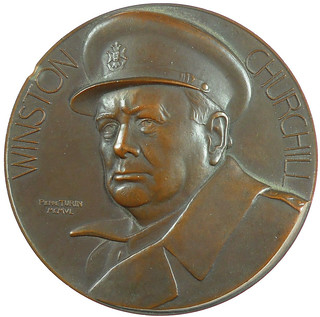
About UsThe Numismatic Bibliomania Society is a non-profit association devoted to the study and enjoyment of numismatic literature. For more information please see our web site at coinbooks.org SubscriptionsThose wishing to become new E-Sylum subscribers (or wishing to Unsubscribe) can go to the following web page link MembershipThere is a membership application available on the web site Membership Application To join, print the application and return it with your check to the address printed on the application. Print/Digital membership is $40 to addresses in the U.S., and $60 elsewhere. A digital-only membership is available for $25. For those without web access, write to: Charles Heck, Treasurer AsylumFor Asylum mailing address changes and other membership questions, contact Chuck at this email address: treasurer@coinbooks.org SubmissionsTo submit items for publication in The E-Sylum, write to the Editor at this address: whomren@gmail.com
BUY THE BOOK BEFORE THE COINSale Calendar
|
- WAYNE'S WORDS: THE E-SYLUM JANUARY 31, 2021
- ANS LIBRARY DUPLICATES AVAILABLE ON EBAY
- NEW BOOK: GUIDE BOOK OF CONTINENTAL CURRENCY
- NEW BOOK: CONFIDENT CARSON CITY COIN COLLECTOR
- NEW BOOK: THE SPECIALLY MERITORIOUS MEDAL
- NEW BOOK: MÜNZKABINETT - PEOPLE, COINS, MEDALS
- ALEXANDRE VATTEMARE ADDENDA REDISCOVERED
- VIDEO: FUN COIN CONVENTION 2001
- NOTES FROM E-SYLUM READERS: JANUARY 31, 2021
- WHITMAN MARCH 2021 BALTIMORE EXPO CANCELLED
- STACK'S BOWERS MARCH 2021 AUCTION MOVES TO VEGAS
- UPCOMING ANA ELEARNING ACADEMY CLASSES
- VOCABULARY TERM: COLLAR
- HENRY CLAY BOWMAN (1842-1925)
- HARVEY STACK'S NUMISMATIC FAMILY, PART 88
- ART BERNSTEIN APPOINTED TO THE CCAC
- LOUIS GOLINO: 10 YEARS OF MODERN NUMISMATICS
- DAVISSONS ANNOUNCES E-AUCTION 40
- MORE HUNTER COLLECTION COLONIAL NOTES
- HERITAGE OFFERS NEW YORK NATIONAL BANKNOTES
- AIZANOI TURKEY COIN HOARD FOUND
- THE DIG - UNEARTHING THE SUTTON HOO TREASURE
- THE 2021 MORGAN DOLLAR
- HARD TIMES TOKENS AND SCRIP
- NUMISMATIC COMMEMORATIONS OF VACCINATION
- NEW MOMENTUM TO PUT HARRIET TUBMAN ON $20 BILL
- RAID NETS UK'S LARGEST COUNTERFEIT SEIZURE
- HONG KONG COUNTERFEIT BANKNOTES RISING
- LOOSE CHANGE: JANUARY 31, 2021
Click here to read the thin version on the web
Click here to subscribe
Click here to access the complete archive
To comment or submit articles, reply to whomren@gmail.com
Content presented in The E-Sylum is not necessarily researched or independently fact-checked, and views expressed do not necessarily represent those of the Numismatic Bibliomania Society.
WAYNE'S WORDS: THE E-SYLUM JANUARY 31, 2021
 New subscribers this week include:
Bill "Buck" Rogers, courtesy Bruce Perdue;
Matthew Chiarello, and
Georges Depeyrot.
Welcome aboard! We now have 6,605 subscribers.
New subscribers this week include:
Bill "Buck" Rogers, courtesy Bruce Perdue;
Matthew Chiarello, and
Georges Depeyrot.
Welcome aboard! We now have 6,605 subscribers.
Thank you for reading The E-Sylum. If you enjoy it, please send me the email addresses of friends you think may enjoy it as well and I'll send them a subscription. Contact me at whomren@gmail.com anytime regarding your subscription, or questions, comments or suggestions about our content.
This week we open with an ANS library duplicate sale, four new books, updates from the Newman Numismatic Portal, coin show and auction news and more.
Other topics this week include Alexandre Vattemare, the FUN show, ANA online classes, a new CCAC member, upcoming auctions, treasure hunting (and finding), Hard Times Tokens, the 2021 Morgan dollar, counterfeit banknote seizures, Harriet Tubman, and numismatic commemorations of vaccination.
To learn more about Continental Currency, Carson City coinage, the Specially Meritorious Medal, whirligigs, Half Cents, the Black Death, tri-segmented collars, the Detmer Collection, the Henry I Quatrefoil Penny, the Boston School Medal, the Revere "Sword in Hand" note, the Sutton Hoo, and the New York Fed gold vault, read on. Have a great week, everyone!
Wayne Homren
Editor, The E-Sylum

ANS LIBRARY DUPLICATES AVAILABLE ON EBAY
The American Numismatic Society has an eBay store, and this week they will be offering library duplicates for sale. -Editor
Library Duplicates available on the ANS eBay store
We will begin adding duplicates from the ANS's Harry Bass Library to our eBay store, beginning next Tuesday evening (2/2) with some auction catalogs. All lots start at $1. This week we will post auction catalogs from Ratto, L. Hamburger, J. Hamburger, Frankfurter, and Calicó (Asociación Numismatica Española). Also included is the Canessa catalog of the gold portion of opera tenor Enrico Caruso's collection.

To visit the ANS eBay store, see:
https://www.ebay.com/usr/american-numismatic-society

NEW BOOK: GUIDE BOOK OF CONTINENTAL CURRENCY
The latest Whitman Publishing book by Q. David Bowers, the Guide Book of Continental Currency and Coins, will debut in early March 2021. The 288-page book, volume 25 in the popular Bowers Series of numismatic references, will be available from bookstores and hobby shops and online (including at Whitman.com) for $19.95. Here, Whitman publisher Dennis Tucker discusses the scope of the new book. -Editor
 Continental Currency, the Dream of American Independence, and Connecting Cash to History
Continental Currency, the Dream of American Independence, and Connecting Cash to History
New Q. David Bowers Book Explores the Money of the Revolution
by Dennis Tucker
As a publisher and a numismatist, I'm always on the lookout for "coin books" that can leap from the hobbyist world of antiques and collectibles into the bigger river of mainstream American history. This goal is more elusive than you might expect. But the potential is always there, because the pleasures of coin collecting and the pleasures of studying history are so closely related.
If you're an active collector of old coins, paper money, tokens, and medals, you appreciate the connections between these objects and the broad tapestry of our national story. They're fundamental pieces of material culture—a scholarly term for the physical objects, resources, and architecture that surround us and define us (things that help us survive, that aid our labor, that create an identity, that solidify social relationships, etc.). Coins and paper money have been used in North America day in and day out for generations, going back to the colonial era. They're as intimately connected to American life as are newspapers, family portraits, silverware, and letters mailed back home. History you can hold in your hand, as it has been said.
The study of coins and paper currency is part of the art and science of numismatics. The wider discipline covers the study of all aspects of money, as well as other payment media and systems (such as barter) that humans have used to settle debts and exchange goods. Numismatics involves other social sciences: economics, quantitative and qualitative economic history, political science, and the like. Its scope also includes mining, metallurgy, mechanics, and other hard sciences and technology that go into the physical creation of coins and printing on paper. It includes design, sculpture, engraving, and fine arts similarly involved in making coins and bank notes. For a numismatist, a coin is much more than just a coin! It's an artifact of its times. It has a lot to tell about the people who created it, and those who used it.

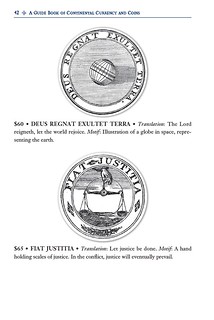
In our fast-paced world, historians as a general class rarely get the credit they deserve for helping us understand the past (and thereby the present). This has been changing in recent years, and it's gratifying to watch as serious history grows into a popular consumable. A case study: Lin-Manuel Miranda's 2015 smash-hit musical Hamilton, itself based on historian Ron Chernow's award-winning 2004 book Alexander Hamilton, about the Founding Father who created the nation's financial system and was our first Treasury secretary.
The entertaining packaging of history is perhaps good and bad for numismatics. On the one hand, anything that popularizes history—assuming it's well researched and balanced—is good for elevating knowledge overall, and has the potential to spark interest in history's many highways and byways, including all manner of material culture. On the other hand, with so much entertainingly produced history available, in so many easily accessible formats (television, movies, online videos, even Broadway musicals), a quieter avenue like coin-collecting might get lost on the map. Numismatics, misunderstood, could run the risk of being sidelined as a narrow specialty—one where you "learn more and more about less and less, until you know everything about nothing"—rather than being appreciated as a permeating science that touches every aspect of American life.
As the subtitle of author Todd Andrlik's 2012 book Reporting the Revolutionary War says, "Before it was history, it was news." This applies to money as much as anything, and it's important to remember that before coins and paper currency became historical collectibles, they were new, freshly minted or printed, often experimental, and, during the American fight for independence, a vibrant act of revolution themselves. Capturing that energy and sense of uncharted newness, while bringing order to its complexity, is a challenge. Among American historians, none is so qualified to write about the money of the American Revolutionary War as Q. David Bowers. His work in the field, which started in the 1950s, is innovative, prolific, and ongoing.
With more than fifty books to his credit, Bowers ranks among the greats of our nation's historians—those who have lifted high the lamp of knowledge. Certainly in the field of economic history he is a unique, and uniquely productive, author.
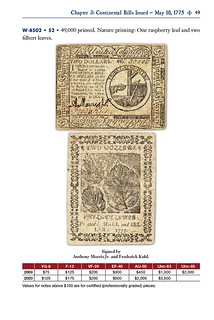

Bowers and the Bridging of the Mainstream History / Numismatics Gap
Dave Bowers has anecdotally told the story of a well-known Civil War historian he chatted with after a lecture. He asked the expert what he knew about Civil War money. The reply was, essentially, "I know that Confederate currency was nearly worthless before the end of the conflict." No deep knowledge of the wartime birth of new banking systems, no intimacy with the way the nation's biggest military mobilization was financed. On the level of day-to-day life during the war, he could share nothing of, for example, the vital role played by little bronze tokens minted in the tens of millions by hundreds of private businessmen. Were those tokens "money"? Were they crucially important to Americans during the early 1860s? Yes and yes! "Civil War tokens" fueled the engine of daily commerce after all legal-tender federal coins—not just gold and silver, but even lowly copper cents—were hoarded by a fearful and war-weary public. Knowledge of this sort goes beyond valuing coins and currency as "collectibles." It gets to the heart of their true worth, as artifacts of the American experience.
In the Guide Book of Continental Currency and Coins (publication date: March 2021), Dave Bowers has written a volume that bridges the gap between numismatics and mainstream history. He provides a fresh understanding of the American Revolution using numismatics as his lens. For many readers this will be radical and new. History buffs who know the battles, the generals, and the politics will now also understand the financial and economic forces of the Revolution. This is not a dusty math lesson or a lecture on the "dismal science" of economics. Rather, it's a fascinating exploration of national-level financial experimentation, as well as the day-to-day monetary life of Americans, both Tory and revolutionary.
How was Continental Currency produced; how were the notes distributed? Who signed them? Before all that, how were they even authorized—when the Continental Congress had no traditional foundation for a paper-money issue, no gold or silver to back up the paper and ink? How could Congress raise money to fight a war that was partially enflamed by tax collection? How strong was the promise to redeem the paper after the war? Such a promise would require an unruly volunteer army to conquer the greatest military force on earth!
The human stories that emerge are sometimes funny, sometimes terrifying, and always enlightening. Did a New Yorker really wallpaper his rooms with Continental Currency during the war? How did General Washington threaten those who refused to accept the money as payment for goods? What happened to Quakers who, for religious reasons, refused to handle the paper money? What were Spanish silver dollars, and how did they figure into the emerging economy? How did the eccentric Massachusetts businessman "Lord" Timothy Dexter make a fortune speculating in war debt and Continental Currency?

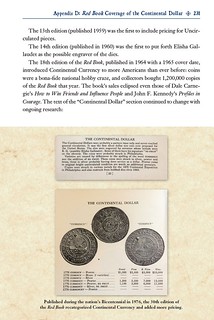
Some facts are surprising, and rarely covered in histories of the Revolution—for example, it was illegal during the war to say anything negative about the new paper money, and many Americans were jailed for public criticism, a concept that would be unthinkable to later generations. Bowers shares and comments on newspaper accounts from both sides of the conflict, some neutrally reporting the monetary news of the day, some degrading the "dirty trash" currency. He tells of citizens "burnt in the brawn of the left thumb" for the crime of passing counterfeit money—and even being executed for the "pernicious tendency."
On the artistic and technical side, Bowers lays out the designs and rich symbolism used on Continental Currency notes. He tells how they were printed, and the ingenious techniques employed to frustrate counterfeiters. And he tells of Benjamin Franklin and others who influenced the look and feel of the new money.
For collectors, he describes how to grade Continental Currency—a factor crucial to valuation. He gives rarity ratings, typical prices in multiple grades, and advice on market conditions.
He explores the enigmatic Continental dollar coins (or are they medals?), laying out a couple hundred years of research and speculation, including startling recent theories based on new research and insights.
A Modern-Day Benson Lossing
Within the discipline of numismatic history, Q. David Bowers has no peers. He's extremely productive, he's popularized the field and connected it to other social sciences, and he's influential and inspirational to other researchers. The Guide Book of Continental Currency and Coins adds to his standing among American historians, and continues to elevate the status of numismatics as a serious branch of American history, as important as the popular works of Benson J. Lossing or Barbara Tuchman or David McCullough—a companion to presidential and other political history, social-movement history, military history, and every other highway and byway that history buffs happily explore.
For more information, or to pre-order, see:
A Guide Book of Continental Currency and Coins
(https://whitman.com/a-guide-book-of-continental-currency-and-coins/)

NEW BOOK: CONFIDENT CARSON CITY COIN COLLECTOR
Marie Goe of Southgate Coins and Collectibles submitted this announcement of Rusty Goe's new three-volume work. Thanks! Wow. -Editor
 The Confident Carson City Coin Collector
The Confident Carson City Coin Collector
Three volumes, 2,500 pages
Hardbound
Color images
$299 plus $16 shipping
I wanted to give E-Sylum readers a few words about Rusty's new book. He has spent more than ten years working on it. For the past three and a half years he has relentlessly pursued its completion. As expected, 2020 proved to be a very challenging year. Rusty experienced many setbacks in his book project along the way. He never gave up, though.
The result is a massive three-volume hardback set, comprising 2,500 pages (1.5 million words). The book's title is The Confident Carson City Coin Collector. Volume 1 comprises 850 pages; Volume 2 runs slightly more than 1,010 pages; and Volume 3 is the short one, with its 640 pages. The set will debut during the first week in February 2021.
David Bowers wrote the Foreword, which appears in Volume 1. Color images fully illustrate the book. Many tables and appendices are spread throughout the volumes.
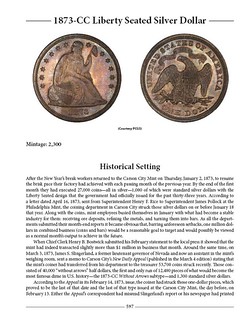

Rusty has poured everything he has learned about the Carson City Mint and its coins during the past three-plus decades into this new book (set). So much new information permeates the pages, it is difficult to know where to begin in listing examples. Rare coin auction catalogers will find fresh, new data, historical material, and anecdotes to use in their descriptions of Carson City coins. Collectors will find everything they need to thoroughly enjoy their pursuit of "CC" coins. History buffs will relish the experience of reading the Historical Setting sections in the volumes.
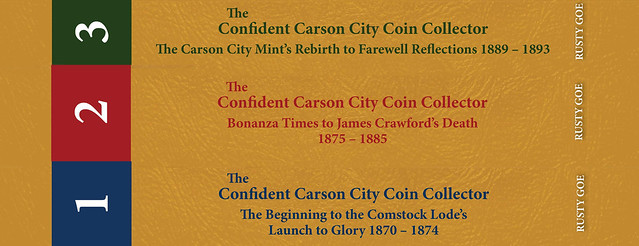
Marie adds:
"We will offer the three-volume set on our website, www.southgatecoins.com. In time, we will place the set on Amazon. Heritage Auctions has already ordered a substantial quantity. As soon as they receive their sets they will be offering them on their platform. Shipping will cost $16. The 22-lb. weight of each set necessitates this amount.
"We know this is a steep price for a numismatic reference work. Our production costs greatly exceeded our expectations. Not to mention the thousands of hours Rusty devoted to researching and writing. If we sell all the sets we will not even come close to breaking even. Rusty is not concerned about this, however. This is his gift to numismatics in the present and in the future. It is his expression of gratitude for all the cherished memories numismatics has provided him for decades."
Here's an additional description from the back cover of Vol 1. -Editor
"A Companion's Guide to the History of the Carson City Mint and an Appreciation of its Coins" is a subtitle that describes the author's intent for the three-volume set comprising The Confident Carson City Coin Collector. In these volumes Rusty Goe, a universally recognized authority on these topics, shares with fervor, honesty, and user-friendliness what he wants collectors to know about Carson City coins and the mint from where they came.
Goe accomplishes his task by sketching the Carson City Mint's history from when it was only a dream in the minds of frontier settlers, through its incipient days, through its coinmaking years, to the permanent cessation of its stamping machines. Volume 1 launches readers into a captivating narrative that begins with the establishment of Nevada's coin factory and closes at the end of 1874, the mint's fifth year of operations.
The 111 different date-denominations that represent the Nevada mint's medley of coins produced between 1870 and 1893 form the core of these volumes' subject matter. Goe allows the coins fashioned in these 111 varied date-denominations to tell their own stories, which, when woven together, produce one of the most epic legacies in all of U.S. numismatics.
Many basic notions abound about the Carson City Mint's history and the coins that were produced there. Many are accurate, while others are merely conjectural, or even worse, blatantly false. The intention of this three-volume set is to lay as accurate a foundation as possible regarding all topics related to the Carson City Mint and its coins so that future studies in this field will benefit from it. Additionally, Goe asks two questions: (1) What gives a collector confidence when pursuing Carson City coins? and (2) How does a knowledge-based approach to coin collecting add layers of value to the experience? In these volumes' pages he capably answers these questions.
The 111 different date-denominations are presented differently in these volumes than is the usual custom in numismatic reference books. For example, for the year 1870 the six denominations minted are clustered together in denominational order. For each, two primary sections divide the content. First is the "Historical Setting" segment. Second is the "Coin Commentary" exposition. Throughout, many important avenues of study regarding history and coins are explored.
For more information, or to order, see:
https://www.southgatecoins.com/
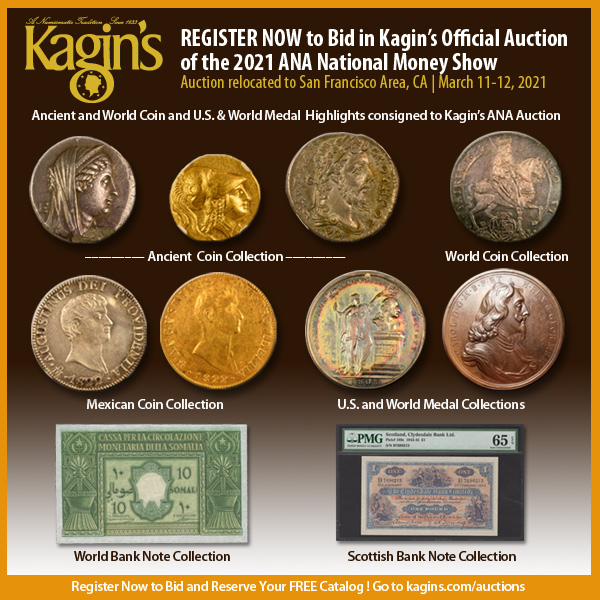
NEW BOOK: THE SPECIALLY MERITORIOUS MEDAL
Nick McDowell of Foxfall Medals submitted this announcement of a new monograph on the U.S. Navy's Specially Meritorious Medal. Thanks! -Editor
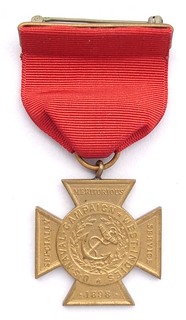
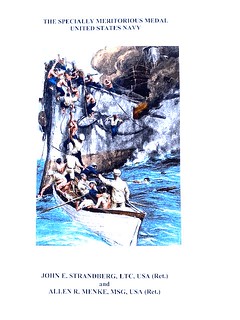
The Specially Meritorious Medal – United States Navy, by John E. Strandberg and Allen R. Menke is a 55-page monograph that provides details on the production history of this rare medal and gives details on its die varieties. A comprehensive section of exhibits includes extracts of original documents and a detailed list of each authorized recipient. The 8.5x11 format allows for multiple color photos of original medals showing details of the various original varieties and official engraving styles.
Also shown are examples of spurious engravings as well as the specially prepared medal to Paymaster William Gault for actions supporting Admiral in Dewey in the Philippines. Spiral bound with a clear front cover and black vinyl rear cover. Available from the Foxfall Press for $23.60, which includes shipping to addresses (in the United States) and PayPal fees. Send PayPal payment to foxfall.medals@gmail.com or by check to Foxfall Medals at Post Office Box 710, Madison, VA 227278.
THE BOOK BAZARRE
NEW BOOK: MÜNZKABINETT - PEOPLE, COINS, MEDALS
Battenberg Verlag has published a new book by Bernhard Weisser on the coin collection of the State Museums in Berlin. Found via the Geldscheine-Online newsletter. Here's a Google-translated description. -Editor
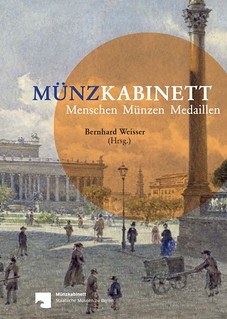 Bernhard Weisser
Bernhard Weisser
Münzkabinett - people, coins, medals
Published by Battenberg Verlag
ISBN: 978-3-86646-202-1
Edition: 1st edition 2020
Images: color throughout
Hardcover: 384 pages
Format: 17 x 24 cm
The origins of the collections of the Münzkabinett (Coin Cabinet) of the State Museums in Berlin go back to the electoral art chamber of the 16th century. The Münzkabinett has been an independent museum since 1868. The 150th anniversary and an associated exhibition provided an opportunity to reflect on the history of the largest and most important collection of old money in Germany. The focus was particularly on the people who are associated with the Münzkabinett. The publication, in which twelve authors participated, is also understood as a determination of the position at a time in which museums are exposed to new challenges.
Münzkabinett – Menschen, Münzen, Medaillen
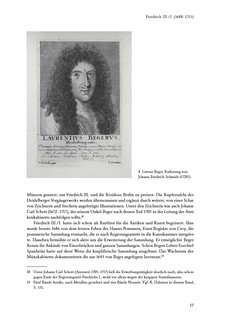
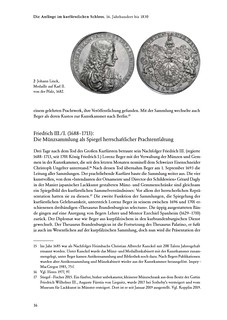
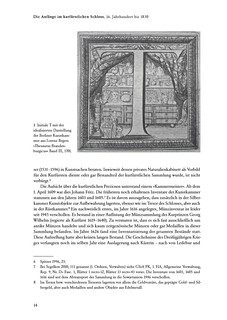
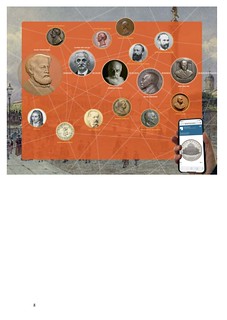
To read sample pages, see:
https://www.battenberg-gietl.de/pdfs/8133cd8a-02fb-470f-945d-889b752bfc08.pdf
For more information, or to order, see:
Münzkabinett – Menschen, Münzen, Medaillen
(https://www.battenberg-gietl.de/sammeln/buch/muenzkabinett-menschen-muenzen-medaillen)

ALEXANDRE VATTEMARE ADDENDA REDISCOVERED
The latest addition to the Newman Numismatic Portal is an 1864 article on Hard Times Tokens by Alexandre Vattemare. Project Coordinator Len Augsburger provided the following report. -Editor
 Wayne Homren recently purchased a DVD compilation of public domain works on numismatics. The description of this offering included a work on American numismatics by Alexandre Vattemare,
dated 1864. Vattemare's 1861 volume, Collection de Monnaies et Médailles de L'Amérique du Nord de 1652 a 1858, is well-known and represents one of the earliest catalogs of U.S. coinage. This 1864 work was completely unknown to Wayne, or Len Augsburger.
Wayne Homren recently purchased a DVD compilation of public domain works on numismatics. The description of this offering included a work on American numismatics by Alexandre Vattemare,
dated 1864. Vattemare's 1861 volume, Collection de Monnaies et Médailles de L'Amérique du Nord de 1652 a 1858, is well-known and represents one of the earliest catalogs of U.S. coinage. This 1864 work was completely unknown to Wayne, or Len Augsburger.
After receiving the DVD, Wayne discovered, with the help of the numismatist's friend Google, that the 1864 work was actually an article published by Vattemare in the Revue Numismatique for that year. This article expands upon and reorganizes Vattemare's chapter on Hard Times tokens from the 1861 book. Vattemare perhaps envisioned a second edition of the 1861 volume, but was able to publish only this revised chapter.
See also Q. David Bowers' Alexandre Vattemare and the Numismatic Scene (Stack's Bowers, 2018), with foreword by David Gladfelter, and The Extravagant Ambassador (Boston Public Library, 2007), which includes an article by Alan Stahl, "Vattemare and Numismatics."
Link to Vattemare's Revue Numismatique 1864 article on Newman Portal:
https://nnp.wustl.edu/library/publisherdetail/541416
Link to Vattemare's Collection de Monnaies et Médailles de L'Amérique du Nord de 1652 a 1858:
https://nnp.wustl.edu/library/booksbyauthor/537242
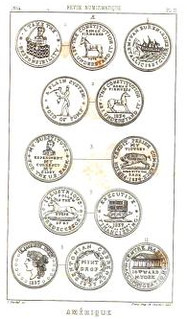
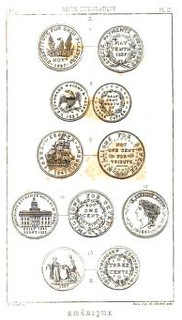
My purchase was driven by my curiosity over one title on the DVD offered by an eBay seller in Israel: Numismatique des États-Unis d'Amérique. I was familiar with Vattemare's 1861 work, but not this. Checks of NNP, library catalogs, and online search came up empty. Neither Len nor David Gladfelter were aware of it. Given that the DVD cost just $10 postpaid, that was enough for me. I ordered it, hoping to be able to add a new title to the Newman Portal. I have both of the above-mentioned books (I highly recommend both), and could not find it referenced.
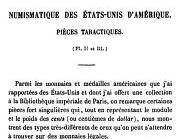 When the disc arrived, it took quite a while to run a virus check - there were 3,471 files totalling 2.95 GB, all out-of-copyright works likely copied from public websites. Only a few of the folders contained documents relating to U.S. numismatics. All the titles were familiar and available on NNP except Numismatique des États-Unis d'Amérique.
When the disc arrived, it took quite a while to run a virus check - there were 3,471 files totalling 2.95 GB, all out-of-copyright works likely copied from public websites. Only a few of the folders contained documents relating to U.S. numismatics. All the titles were familiar and available on NNP except Numismatique des États-Unis d'Amérique.
A subfolder contained a set of 12 .png image files. There was no index or table of contents - no information about the work other than the title. It was not the same as Vattemare's 1861 publication, and looked like it came from a periodical. Long story short, the two plates were from Revue Numismatique, and I located the original article scans online - they'd been made by Google Books some years ago.
It was a fun diversion, and more of a rediscovery than a true discovery, but satisfying nonetheless. I'm glad to see this article get some renewed attention. -Editor
David Gladfelter writes:
"The article appeared in vol. 9, new series (1864) of Revue Numismatique. It expands upon pages 67-70 in the 1861 work, by adding historical comments as well as some new pieces. In the introductory section of the article, Vattemare claims that the U. S. Constitution permits only the federal government to coin money (it actually prohibits states from coining money), meaning gold and silver coins, but that (as of the Hard Times era) there was no restriction on making and circulating private copper tokens. Because copper coins did not circulate, he says, the copper satirical pieces were put in circulation and readily accepted. That is why he listed the Hard Times tokens under "monnaies," as he did with pre-federal coppers including the state issues. He describes the Feuchtwanger German silver token (#18 in the article) as being made of "an intermediate metal between silver and copper".
"16 tokens are described in the book and 18 in the article. I found at least one duplication – No. 2 in the article is the same piece as No. 1 in the book. It would not be too difficult to match up the Vattemare numbers with Low or Rulau numbers."
"It turns out George Fuld knew all about Vattemare's 1864 article, and mentioned it in his commentary in the catalog of Stack's auction of the Alan Scott Fisher collection of HTTs in 2004.
"Although Vattemare makes mention of his 1861 study of North American coins and medals, I think that the RN article was intended to be a stand-alone piece, not a supplement to the book.
"The article may have been published posthumously. Vattemare died on April 7, 1864."
Len adds:
"Presumably the pieces referenced remain in the Bibliotheque Nationale collection today."
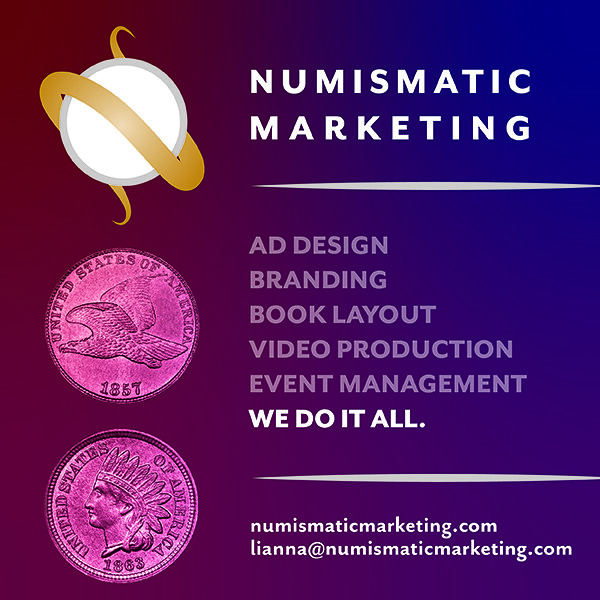
VIDEO: FUN COIN CONVENTION 2001
These are selections from the David Lisot Video Library that feature news and personalities from the world of coin collecting. David has been attending coin conventions since 1972 and began videotaping in 1985. The Newman Numismatic Portal now lists all David's videos on their website at:
https://nnp.wustl.edu/library/multimediadetail/522852
Here's one on the 2001 FUN Coin Convention. -Editor
FUN Coin Convention 2001
Video Producer: David Lisot
 Are you are bored with being isolated from the COVID Virus and not being able to get out of the house? If you like numismatics and the people involved this video is for you! This is unedited footage from Florida United Numismatists Convention 2001. You will see collectors and dealers from 20 years ago. So if you go to the FUN Convention or know people who do you might get some chuckles! It lasts more then an hour so just tune in and enjoy.
Are you are bored with being isolated from the COVID Virus and not being able to get out of the house? If you like numismatics and the people involved this video is for you! This is unedited footage from Florida United Numismatists Convention 2001. You will see collectors and dealers from 20 years ago. So if you go to the FUN Convention or know people who do you might get some chuckles! It lasts more then an hour so just tune in and enjoy.
The video is available for viewing on the NNP at:
https://nnp.wustl.edu/library/book/584241
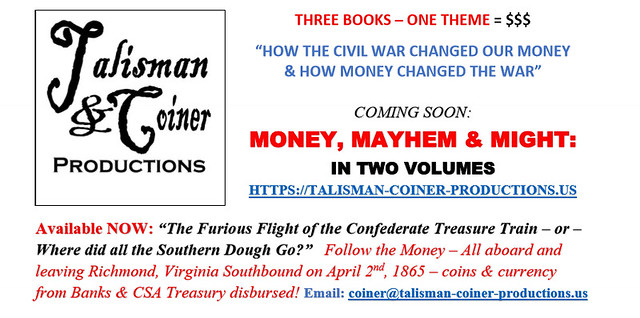
NOTES FROM E-SYLUM READERS: JANUARY 31, 2021
Coin Whirligigs
John Phipps writes:
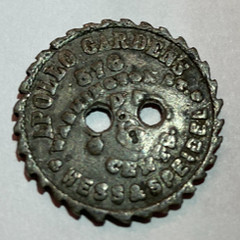 "When I was a kid and reading Boy's Life and Popular Mechanics regularly, I remember seeing an article on how to make a clock by hand (like a mechanical Heathkit project). At the time, my father and I were both coin collectors and into working on shop projects in the garage so we both noticed it. We weren't interested in this project so my memory is nothing more than noticing the article. So maybe some of these "pie crimpers" are "gears" for a clock or other whirligig. That might explain the one with two holes."
"When I was a kid and reading Boy's Life and Popular Mechanics regularly, I remember seeing an article on how to make a clock by hand (like a mechanical Heathkit project). At the time, my father and I were both coin collectors and into working on shop projects in the garage so we both noticed it. We weren't interested in this project so my memory is nothing more than noticing the article. So maybe some of these "pie crimpers" are "gears" for a clock or other whirligig. That might explain the one with two holes."
Dave Karstaedt writes:
"The 2 holed pie crimper is neither a pie crimper nor a button. It is a child's toy called a whizzer. These are commonly found on colonial and early sites. They are often made of lead discs but can also be made from coins. The edges are often cut or serrated. A string is threaded through the holes in a special way. Then the whizzer is wound up then the string is pulled back and forth making the disc spin fast. This causes a whistling sound."
John Sallay writes:
"The piece pictured in last week's E-Sylum in "Merriam Token Two-Holed Pie Crimper" is not a pie crimper, but a spinner, created as a toy for a child (or a numismatist with too much time on his hands). These have been made for hundreds, maybe thousands of years, though I've never seen an ancient coin made into one. They are also sometimes called button spinners, thread spinners, buzzers, whirligigs, and probably other things as well. In this case the edges are notched to create a buzzing sounds as it rotates at high speed."
A video is worth thousands of words. John kindly included links to a couple of excellent YouTube videos of multi-holed whirligigs in action. Thanks! Check 'em out. The second one has more discussion, plus some discussion of different types. -Editor

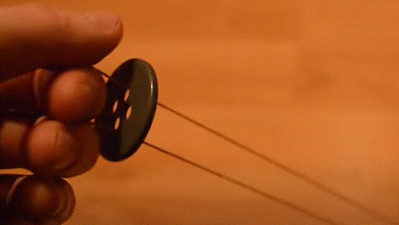
To watch the videos, see:
Thread Spinner - The Button-Thread Toy - Buzz Saw Toy
(https://www.youtube.com/watch?v=-QMmfDhrZxg)
Button Spinners
(https://www.youtube.com/watch?v=KBNjnvVHtX4)
To read the earlier E-Sylum article, see:
NOTES FROM E-SYLUM READERS: JANUARY 24, 2021 : Merriam Token Two-Holed Pie Crimper
(https://www.coinbooks.org/v24/esylum_v24n04a18.html)
Tulsa Race Massacre Numismatic Survivors
Last week we discussed a medal given by the Oklahoma state legislature to survivors of the 1921 Tulsa Race Riot. Here's another numismatic connection to the event. -Editor
Len Augsburger writes:
"In the last chapter of Tim Madigan's The Burning (2001), he describes a meeting with George Monroe, a 96 year old survivor of the Tulsa race massacre."
Here's the passage. -Editor
"Some days now, George Monroe wears a remarkable souvenir from that day, a pendant made of dimes that were melted together when his family home burned. And he still wonders why people could be so mean for no good reason at all. In all these years, no one has been able to answer that for him. The best folks can do is to listen to his story and join in with his remembrances. Now he takes a sip from a beer, rises from his chair and disappears into a back room of the home. In a minute, he returns holding a blackened penny, one of hundreds his family extracted from the ruins of their place so long ago. "That's a penny you can keep," he says, handing it over. "Keep that penny as a reminder."
Interesting! Thanks. I hope those burned relics remain preserved and properly documented. I'm still curious to learn more about the gold-plated medals presented by the state to survivors. -Editor
To read the earlier E-Sylum article, see:
QUERY: TULSA RACE RIOT SURVIVOR MEDALS
(https://www.coinbooks.org/v24/esylum_v24n04a22.html)
For more information, or to order the book, see:
THE BURNING
The Tulsa Race Massacre of 1921
(https://us.macmillan.com/books/9780312302474)
The Japan Craze
Ted Puls writes:
 "I loved seeing the framed Japanese coin article at the end of the last E-Sylum. I enjoyed seeing a similar item when visiting the ANA Library. It was on the wall near the books on Chinese coins. Sadly this item was stolen by someone not reading the nearby books, to know that the coins were fake. I wonder if these displays were "mass-produced"?"
"I loved seeing the framed Japanese coin article at the end of the last E-Sylum. I enjoyed seeing a similar item when visiting the ANA Library. It was on the wall near the books on Chinese coins. Sadly this item was stolen by someone not reading the nearby books, to know that the coins were fake. I wonder if these displays were "mass-produced"?"
All things Japan were a big craze at one time, and these decorative art frames are likely from the 19th-century versions of Home Goods. See the complete article linked at the bottom of the earlier piece. -Editor
"Many of these framed objects have connections to some of the 19th century's great curio shops that specialized in the manufacture and selling of Japanese decorative arts objects, silvers, furniture, and lacquers to European collectors."
To read the earlier E-Sylum article, see:
LOOSE CHANGE: JANUARY 24, 2021 : Framed Displays of Japanese Money
(https://www.coinbooks.org/v24/esylum_v24n04a37.html)
Churchill in a Military Cap
Chip Howell writes:
"Purely by serendipity, I ran across a coin w/Churchill in a military cap just this evening: Liberia $10, 1995 (KM#145)"
Chip was responding to my comment about this medal, noting that I hadn't seen a coin or medal depicting Churchill with a military cap. I found a similar dollar coin on Numista. -Editor


Chip adds:
"That coin (KM#140) is the same design as the one I saw (KM#145)
"I made the "mistake" of typing "Churchill" into Numista, and came up with several other examples.
"This is very much a minority among his depictions, as you referenced--most are bare-headed or w/homburg et al."
To read the earlier E-Sylum article, see:
NUMISMATIC NUGGETS: JANUARY 24, 2021 : Churchill Navy Medal
(https://www.coinbooks.org/v24/esylum_v24n04a33.html)

WHITMAN MARCH 2021 BALTIMORE EXPO CANCELLED
Another major coin show has fallen victim to the pandemic. Here's the press release. -Editor
 The March 25–27, 2021, Whitman Coin & Collectibles Baltimore Expo will not be held as Maryland continues to mitigate the COVID-19 coronavirus pandemic. The Baltimore Convention Center notified Whitman Coin & Collectibles that the event was canceled for March 2021.
The March 25–27, 2021, Whitman Coin & Collectibles Baltimore Expo will not be held as Maryland continues to mitigate the COVID-19 coronavirus pandemic. The Baltimore Convention Center notified Whitman Coin & Collectibles that the event was canceled for March 2021.
The show's manager plans an expanded "MEGA Bourse" for the June 3–5 Expo, one of the largest numismatic events of the year. It will be held at its regular venue, the Baltimore Convention Center.
Whitman Expo manager Lori Kraft said, "After a long winter, we know that collectors and dealers are eager to get back to business as usual. Nothing beats the excitement of attending a major show in person—and our summer Baltimore Expo will be MEGA."
Kraft and her Expo team are working to make the June 2021 Baltimore Expo the largest ever. "We will be expanding the bourse to accommodate all dealers that annually attend our March and June events. We encourage first-time dealers to sign up for the June Mega bourse. We anticipate that hobbyists and the public will be out in full force. We want to welcome people to the Convention Center for a fun, energetic show, while keeping everyone comfortable and safe."
A lineup of new Whitman Publishing books, and educational events and exhibits, is planned for the show.
Whitman's Guide Book of United States Coins, known hobby-wide as the "Red Book," celebrates its 75th anniversary in 2021. The June Baltimore Expo will be the scene of giveaways and events in recognition of this numismatic milestone. In addition, the seventh edition of MEGA RED, the expanded 1,504-page version of the Red Book, will be available at the show. Its expanded feature section focuses on silver and modern dollars.
Other special Expo promotions will center around the ever-popular Morgan and Peace silver dollars. This year marks the centennial of the last Morgans and the first Peace dollars, all struck in 1921. The U.S. Mint will issue special tribute coins later in the year. Collector excitement will also rally around the new American Silver Eagle "Flying Eagle" design, also set to debut this year.
Updates and news about the Baltimore Expo will be posted at expo.whitman.com.
Stack's Bowers Galleries will provide details of its still-scheduled March 2021 auction on their web site, www.stacksbowers.com.
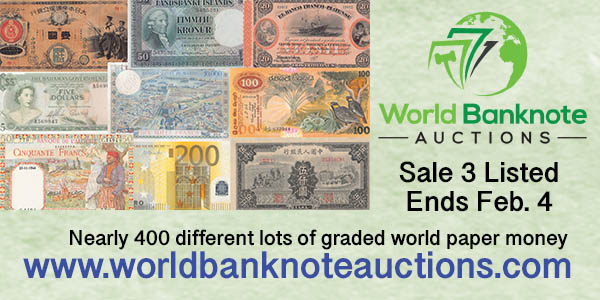
STACK'S BOWERS MARCH 2021 AUCTION MOVES TO VEGAS
Stack's Bowers Galleries is moving their March 2021 sale to Las Vegas. Here's the press release. -Editor

Stack's Bowers Galleries' March 2021 Auction has been relocated and will now be held in Las Vegas, March 23-26 at the Bellagio Hotel and Casino, in coordination with the PCGS Substitute Members Only Show. Lot viewing will take place in California, New York and at the convention venue with dates to be announced. Specific session details will also be forthcoming as the sale date approaches.
"As the Baltimore Convention Center remains closed, we are pleased to once again be associated with the PCGS Substitute Members Only Show in Las Vegas," said Brian Kendrella, president of Stack's Bowers Galleries.
The Stack's Bowers Galleries March Auction will feature a number of historic collections and a diverse selection of numismatic items. United States coins are presented from the Norman G. Peters Collection, the Dr. Jeffrey A. Rudolph Collection, the A.J. Vanderbilt Collection, the E. Horatio Morgan Collection, The Collection of Silas Stanley Roberts, the Fairmont Collection, the Steve Studer Collection, and several others. Early American pieces in the sale include a MS-66 RB (PCGS) 1796 With Pole half cent, an AU-53+ (PCGS) 1793 Liberty Cap cent, and a trio of Draped Bust, Small Eagle half dollars with impressive pedigrees. Other highlights include exceptional Liberty Head and Indian Head gold, two impressive silver ingots weighing over 1,000 ounces each, and many other rarities.
The offering of United States currency is anchored by the magnificent Karelian Collection, which features a PCGS Banknote CU 63 Fr.167a $100 Legal Tender Note, a PMG EF 40 EPQ. Fr. 376 1891 $50 Treasury Note, and a PCGS Banknote Ch EF 45 Fr. 377 1890 $100 Treasury Note.
Clients unable to attend the live auction in Las Vegas can call 800-458-4646 or email info@stacksbowers.com to request phone descriptions from the firm's specialists, place absentee bids, or arrange bidding by telephone. Live bidding will be available through the company's website at www.StacksBowers.com or through their iOS and Android apps using technology recognized as the best in its class by the Numismatic Literary Guild.

UPCOMING ANA ELEARNING ACADEMY CLASSES
As announced earlier, the ANA's new eLearning Academy is open for registration. Here are some upcoming sessions. -Editor
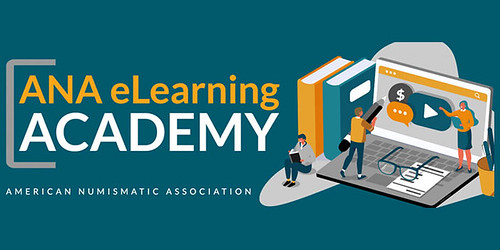
Enjoy live online courses and lectures from fellow collectors and professional numismatists. Webinars are free and open to the public unless otherwise noted. Register now—space is limited!
The Production Technology of Ancient Coinage
For the production of ancient coinage, it was well-known that form follows function. In order to produce a legal coin, it was necessary to have the correct materials and strict controls for its standardized design and production. It is then that the legitimate authority (emperor, empire) approves the striking of a disk or lump of metal, of a certain purity and weight, to produce to official coin that can be used as legal tender. The authority certifies that the newly minted coin is the legal currency, at least within the area governed by that power.
Although the manufacture and production of ancient coinage involve simple tools, their fine quality, design, and extremely beautiful details speak otherwise.
This presentation will focus on various points:
- Metals that have been used for the production of ancient coinage;
- The tools necessary to produce coinage;
- The stages of coinage production;
- The manufacturing techniques, casting, and striking commenting on the benefits of each and on defects that can help in their study;
- The different features and characteristics between Ptolemaic and Roman coinage.
Instructor: Almoatz-bellah Elshahawi
When: February 5, 2021 | 3-4:00 PM MST
Let's Collect Half Cents
U.S. Half cents, which were made from 1793-1857, have a great advantage to collectors of being rare, interesting, and affordable at the same time. Yet, many collectors are unfamiliar with this fascinating series. Most of them were made during the administrations of Washington Adams, Jefferson, and Madison, so they have great historical interest, but you can get many of them in XF-AU (or even better!) for less than the price of a heavily circulated 1909-S VDB cent. This talk will discuss their beauty and artistry, how they were made, and how people collect them.
Instructor: Bill Eckberg
When: February 8, 2021 | 3-4:00 PM MST
Lincoln: The Challenge
Who was Lincoln? This presentation discusses Lincoln as seen through his numismatic portraits over time – from original photographs to medals, coins, and paper currency – who was he and how has his image been used over the last 150 years?
Instructor: Doug Mudd
When: February 10, 2021 | 1-2:00 PM MST
The Second Great Mortality; AKA: The Black Death, 1333-53 & Some of its Coinage
Join Rod Frechette's undertaking of the Second Great Mortality. His revelation on how this dark chaotic period has anything to do with this past year is no longer a mystery. You will be buried with graveside humor on a tour of medieval Eurasia as he shovels up dozens of the 300+ coins of this mortifying period. 20th Century pop culture is interred with the science, religious superstition, history, geography, and personalities of this grim time.
Instructor: Rod Frechette
When: February 11, 2021 | 6:30-7:30 PM MST
Documenting Your Collection: Motives and Methods for Keeping Records of Your Collection
Keeping detailed and accurate records is an important component of any coin collector's hobby experience. Whether your collection is large or small, focused or eclectic, this presentation will get you motivated to make order out of chaos or consider alternative ways to document your collection that will keep you engaged. Reasons for getting organized and multiple methods for documenting your collection will be presented, enabling attendees to pick and choose the motives and systems that are right for them. Incorporating photos, choosing the right backup system, and tips for staying motivated to maintain those records once you get started will also be presented for your consideration.
Instructor: Tim Ferreira
When: February 12, 2021 | 11-12:00 PM MST
Dutch Sieges of the 16th and 17th Centuries
The most prolific era of siege coin production was during the struggle for Dutch independence. The Eighty Years' War was a large-scale insurrection with political roots, economic implications, and deep religious fervor. The story of the events during this period in history can be told by the coins that were created by necessity under the strain of war.
Instructor: Lawrence Korchnak
When: February 16, 2021 | 4-6:00 PM MST
For more information, or to register, see:
https://info.money.org/elearning
To read the earlier E-Sylum article, see:
ANA ELEARNING ACADEMY ANNOUNCED
(https://www.coinbooks.org/v23/esylum_v23n23a06.html)

VOCABULARY TERM: COLLAR
Here's another entry from Dick Johnson's Encyclopedia of Coin and Medal Terminology. It's technical, but well worth a read to learn some of the intricacies of coin striking. -Editor
Collar. A large flat disk or ring – made solid or of multiple segments – with an opening in the center, an aperture of prescribed diameter and machined on the inner wall surface to the requirements of the pieces to be struck. It is the collar that imparts to all coined pieces the shape of their edge: smooth or reeded. All coining dies are collar dies, that is, they are made to strike coins inside the collar, the neck of each die is slightly smaller than the width of the aperture. Also, all coining presses require some form of collar, and have for as long as coins have had uniform edges, certainly since the 1400s. In contrast, medal presses have employed collars – some still do – however, since 1900 most medal presses have utilized open face dies that do not need collars.
Collars can only be used with collar dies whose diameter will match the aperture in the collar. The neck of the dies must be one or two thousandths of an inch smaller than the collar aperture. The measurements must be precise to allow the dies to enter the aperture, strike the blank and retract. Also, the blanks must be an exact diameter to fit inside the aperture, again, several thousandths of an inch smaller than the collar aperture. If not the blanks will jam in the press.
Types of Collars.
cone collar – A collar with minute draft or bevel of the aperture wall for the ease of ejecting the struck piece, wider at the bottom where the struck piece exits.
lettered collar – Always a segmented collar with incised lettering on the inner wall of the aperture to form raised lettering on the edge of the struck piece.
reeded collar— A collar of any kind with serrations on the aperture's inner wall that forms the reeding on the struck piece.
ring collar – A one-piece collar that is one segment obviously with the center aperture.
segmented collar – A collar of multiple segments, usually three, called a tri-segmented collar, which must be dismantled to eject the struck piece with raised lettering or such. smooth collar – The aperture wall has a smooth surface on such a collar to produce a smooth edge struck piece.
split collar – A collar of several segments, same as segmented collar.
toggle collar –
Function of the collar. The collar acts to restrain the outward flow of metal when a blank is struck, at the same time forming the surface of the edge. The coining cycle can be described as follows noting the function of the collar: A blank is brought into coining position by a feeder mechanism. The blank is pushed inside the collar aperture by one of the dies as they enter the aperture during the beginning of the press cycle. The two dies and the collar form the coining chamber. As the dies extend to their fullest length they impress the blank with their full force, driving the design into the surface of the softened blank.
Metal on all surfaces of the blank – both sides and the edge – flow into the design cavities of the dies and up against the inner walls of the collar. Pressure of the press must be established during setup so that the preformed (upset) blank has enough metal to flow into all design cavities with enough left over to flow up against the wall of the collar. All this happens instantaneously.
If the pressure is not great enough, or the blank is light weight (lacking mass), there is not enough metal to flow into all cavities or into the shape of the collar – the piece will not be fully struck up (and could look like an uncirculated worn coin, what a collector would call a die trial). The edge may not be perfectly formed as well, missing knurls or ridges in the reeding.
On the other hand, if the pressure is too great, or the blank is overweight, the metal from such a blank will fill all the cavities then still have excess metal left over to flow into the only open place available to it: the tiny space between the die and the collar. This creates on the struck piece a fin, or burr – what an American collector would call a wire edge and an English collector would call a knife edge – but what a machinist or pressman would call flash.
When the dies are fully extended, the piece is fully struck up, but at this point the piece is "frozen" up against the collar wall. To dislodge it the ejector mechanism is so engineered to propel one of the dies (usually the opposite die from the one that pushed the blank into position) to push the struck piece out of the collar aperture from its "frozen" position.
It is for this reason that the edges of pieces struck in a coining press can only be smooth or reeded – they must be capable of being ejected from the collar. Thus the collar can only be smooth or reeded; the reeding, however, can take many forms – as different number or widths of knurls (ridges) and flutes (furrows) together forming the reeding. Or the edge may have a combination of smooth and reeded areas (interrupted reeding). See reeded edge.
The size, mass and hardness of the collar is important, as the collar must restrain the constant pounding of the metal blanks up against its aperture wall. It accomplishes this by the mass of the collar. As the diameter of the struck piece increases arithmetically, the diameter of the collar increases more so. Two inch coined pieces require a 6-inch diameter collar; a 4-inch coined piece would (should) have a collar as wide as 12 inches.
Collar wear. With very long and continued use the aperture in a collar will grow larger and brighter from wear. The inner wall becomes brighter (like the face of a die) from the constant action of the scraping of the struck metal pieces being pushed out of the aperture.
Numismatic writer Walter Breen reports that cent collars wear the most (undoubtedly so from multi-billion coinages). Cents struck before 1972 used a collar with a 0.747-inch aperture. After 1982 (with the new copper-coated zinc composition) the collar size was increased to 0.749-inch. Breen reports that cent collars at the branch mints (Denver particularly) are not discarded until their aperture enlarges to 0.753-inch.
Striking a blank with pre-formed edge lettering or engrailment. Coin blanks, which first have been treated by the Castaing or canneluring machine with lettering or engrailment, can be struck within a collar but extreme care must be employed. First the blanks must be uniform in size and shape, upset if possible.
When striking these pre-formed blanks the collar to be used must have a smooth chamber wall and a slightly oversize aperture. The pressure must be enough to effect the obverse and reverse impression, but not great enough to mash or deform the edge containing the sunken engrailment or lettering and very slightly bowed edge. The impact against the collar will straighten the edge while the sunken lettering or engrailment remains intact. There may exist a very minute overhang of metal at the top of the letters where metal flowed into these tiny furrows. See lettered collar.
Segmented collar is a special collar made of several segments to effect raised lettering or other reasons. The collar is made of three, four or six sections – usually three – that fit into a retaining ring and held in position by a collar plate.
Segmented collars have been employed for large medals and a smooth edge, however the most important use for the segmented sections are to impart raised lettering. The process is slow in that the assemblage has to be broken apart after each subsequent blow, or to repeat the process for the next piece. Impractical for long production runs, it is more often used for very exotic medals – the raised lettering on the edge places it in a class above all others. The required tooling and additional press time makes this an expensive procedure.
History of the collar. We really do not know who used the first collar for coining. Perhaps it was Aubin Olivier, who, in Paris in 1555, attempted to create an engraved edge with a special collar. It had to have been in use before 1683 (when Thomas Simon created his petition crown). But it was for Jean-Pierre Droz to have improved it even more in Paris in 1683 when he developed the segmented collar (virole brisée). Droz brought the technology with him to the Soho Mint when he was hired by Matthew Boulton in 1789. Here the collar was employed to its fullest extent and changed little since then.
The use of a collar was one of the secrets of early coining. Mintmasters, until the mid nineteenth century, would require all mint workers not to reveal the mechanics of such mechanical devices to anyone outside the mint. This was thought to have helped prevent counterfeiting. The penalty for disclosing the existence of a collar was to have a hand cut off.
References:
C66 {1988} Cooper pp 101, 170-73, illus.
NC8 {1988} Breen.
Also (Droz, Jean-Pierre) Rapport Fait a la Classe des Sciences Mathématiques et Physiques de L'Institut National, Sur Diverses Inventions de Jean-Pierre Droz, Relatives à l'art du Monnoyage. Paris: L'Institut National, Niv?se an XI (December 1804).
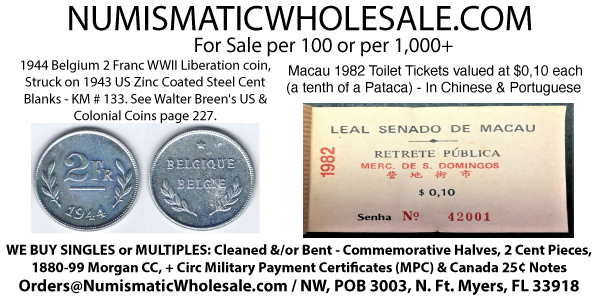
HENRY CLAY BOWMAN (1842-1925)
Here's another entry from the online draft of John Lupia's book of numismatic biographies. Thanks! This is an excerpt with the full article and bibliography available online. This week's subject is collector Henry Clay Bowman of Pennsylvania and Ohio. -Editor
Henry Clay Bowman (1842-1925), was born on October 28, 1842, at Lebanon, Pennsylvania, son of Michael Bowman (1802-1855), and Jane Tennis Bowman (1811-1892).
He served with the Pennsylvania Volunteers during the Civil War.
On November 24, 1872, he married Sophia Sperber (1850-1921), at Des Moines, Iowa. They had six children...
He went into partnership in the crockery business with his older brother Israel Tennis Bowman (1835-1922), in a firm called the Bowman Brothers.
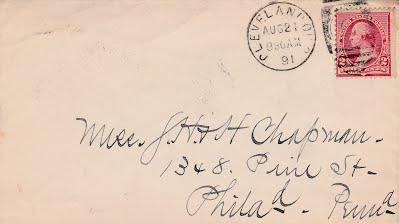
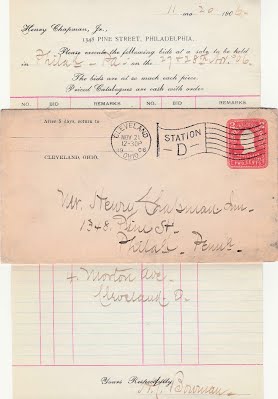 ABOVE: Bowman's correspondence with the Chapman Brothers, ordering a copy of the Warner priced catalogue, postmarked August, 1891, franked by Scott #220.
ABOVE: Bowman's correspondence with the Chapman Brothers, ordering a copy of the Warner priced catalogue, postmarked August, 1891, franked by Scott #220.
AT RIGHT: Bowman's correspondence with Henry Chapman, Jr., sending bids on Henry Chapman's first independent auction the sale of the Leeds collection, together with other information, signed H. C. Bowman, postmarked November 21, 1906, on postal stationery.
His coin collection was sold at auction by Henry Chapman, Jr., on November 28-29, 1913.
He died on December 1, 1925, at Cleveland Heights, Ohio. He is buried at Lake View Cemetery, Cleveland, Ohio.
To read the complete article, see:
BOWMAN, HENRY CLAY
(http://www.numismaticmall.com/numismaticmall-com/bowman-henry-clay)

HARVEY STACK'S NUMISMATIC FAMILY, PART 88
The latest article in Harvey Stack's blog series opens with the year 1983. Thanks. -Editor
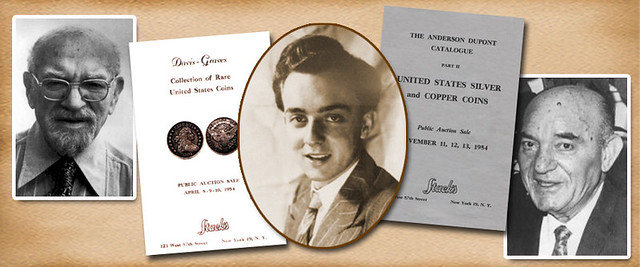
1983 was a super year for Stack's. The markets got stronger, old time collectors had their confidence strengthened, and an avalanche of new enthusiasts seemed to enter the hobby, Stack's experienced a great growth in business, both over the counter and at our auctions, with overall results during this year that were outstanding.
What specifically happened to set this year apart? In 1983 a group of old-time collectors consigned to Stack's for public auction some outstanding collections, primarily of United States coins. In addition, we acquired one of the largest hoards of United States $20 gold double eagles (mostly of the Saint-Gaudens design), to be available since the embargo on importing gold was lifted in 1967. For me personally I had been elected to the board of the Professional Numismatists Guild in 1980 and would become president in 1989. This and the fact that our family had fairly recently lost my father, uncle, and cousin Ben, caused me to step up as a leader in our firm and in the wider numismatic hobby. The Stack's family business continued to grow, with me as Chief Operating Officer, working with my cousin Norman, my son Lawrence (Larry), and a large staff of expert numismatists. We all worked together to deal with clients and present prize-winning and major pedigree auctions. Though this meant a large amount of time away from home, we at Stack's were proud to have maintained our place in numismatics as we celebrated 50 years since our firm opened.
In the early part of the year, Stack's was contacted by a foreign bank to see if we would be interested in acquiring a large holding of United States gold coins, primarily Saint-Gaudens double eagles. We learned that this was among the major banks that received U.S. gold coins as part of government payments. The size of the inventory (the exact number still remains a secret) was so great that we decided that for such a large hoard we would partner with one of our New York colleagues, Manfra, Tordella and Brooks (MTB) to finance and sell this great find nationwide. When we saw the coins, we were surprised and pleased to find that most were in Mint State, as they had been stored in sacks and not disturbed for decades. This was a bonus and we were able to make the deal and bring the coins back to the United States. The fact that MTB was a private bank that dealt in foreign exchange and international banking helped facilitate the payment transfer. This major deal would keep Stack's and MTB busy over the next few years as we distributed these coins to collectors nationwide and through private sales to clients. It was time consuming to spread out these sales over years, but with such a large quantity, it was important to maintain their value on the market and to protect the deal's value to Stack's and MTB.
Our 1983 auction season featured nine separate public auctions that presented some famous collections that had been built over the past half century or more. The number of lots was large and many great rarities in outstanding condition were also included. Collectors who had been active since the end of World War II and before decided it was time to market their collections through Stack's, and give new generations of numismatists the opportunity to enhance and complete their cabinets.
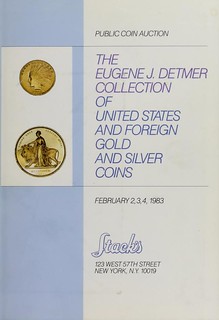 February 1983 brought our offering of the Eugene J. Detmer Collection of United States and world coins, a catalog that comprised over 1,350 lots. Eugene J. Detmer, was a mechanical engineer, who served on the U.S. Navy in the Second World War. His interest in coins began when he served in overseas offices of the Navy during the war, and he visited as many dealers as he could to add to his collection. He was first drawn to early coinage and the sale offered about 484 outstanding lots of ancient gold and silver coins. When he came back to the States, he developed an interest in the gold and silver coins of the United States as well and set out to assemble a noteworthy collection. He amassed nearly 1,000 coins from all series. Highlights among United States gold included a 1854-D $3 (the only one of this denomination struck in Dahlonega), and a $4 Stella, which interested him because of the uniqueness of the denomination. There was a selection of other gold coins from the gold dollar to the double eagle. He specialized in some early $5 half eagles and $10 eagles, because they were among our earliest gold coinage, and among later gold, he had an almost complete set of Indian Head eagles that included both varieties of 1907, a 1920-S, a 1930-S, and the rarely offered 1933. For double eagles he had some great rarities, like 1854-O, 1855-O, 1856-O, 1861-S Paquet, 1870-CC, 1882 through 1887, 1920-S, 1921, 1926-D, 1926-S, 1927-S, 1929, 1930-S, 1931, 1931-D, and 1932. Also of note were gold Proof sets of 1899 and 1905 as well as a great type collection of territorial gold coins. This important collection attracted both old timers and new collectors to participate.
February 1983 brought our offering of the Eugene J. Detmer Collection of United States and world coins, a catalog that comprised over 1,350 lots. Eugene J. Detmer, was a mechanical engineer, who served on the U.S. Navy in the Second World War. His interest in coins began when he served in overseas offices of the Navy during the war, and he visited as many dealers as he could to add to his collection. He was first drawn to early coinage and the sale offered about 484 outstanding lots of ancient gold and silver coins. When he came back to the States, he developed an interest in the gold and silver coins of the United States as well and set out to assemble a noteworthy collection. He amassed nearly 1,000 coins from all series. Highlights among United States gold included a 1854-D $3 (the only one of this denomination struck in Dahlonega), and a $4 Stella, which interested him because of the uniqueness of the denomination. There was a selection of other gold coins from the gold dollar to the double eagle. He specialized in some early $5 half eagles and $10 eagles, because they were among our earliest gold coinage, and among later gold, he had an almost complete set of Indian Head eagles that included both varieties of 1907, a 1920-S, a 1930-S, and the rarely offered 1933. For double eagles he had some great rarities, like 1854-O, 1855-O, 1856-O, 1861-S Paquet, 1870-CC, 1882 through 1887, 1920-S, 1921, 1926-D, 1926-S, 1927-S, 1929, 1930-S, 1931, 1931-D, and 1932. Also of note were gold Proof sets of 1899 and 1905 as well as a great type collection of territorial gold coins. This important collection attracted both old timers and new collectors to participate.
The Detmer sale started off 1983 with a bang for Stack's and set the stage for more great sales to come in the rest of the year.
To read the complete article, see:
Harvey Stack Remembers: Growing up in a Numismatic Family, Part 88
(https://www.stacksbowers.com/News/Pages/Blogs.aspx?ArticleID=harvey-stack-remembers-part-88)
To read the earlier E-Sylum article, see:
HARVEY STACK'S NUMISMATIC FAMILY, PART 87
(https://www.coinbooks.org/v24/esylum_v24n03a17.html)
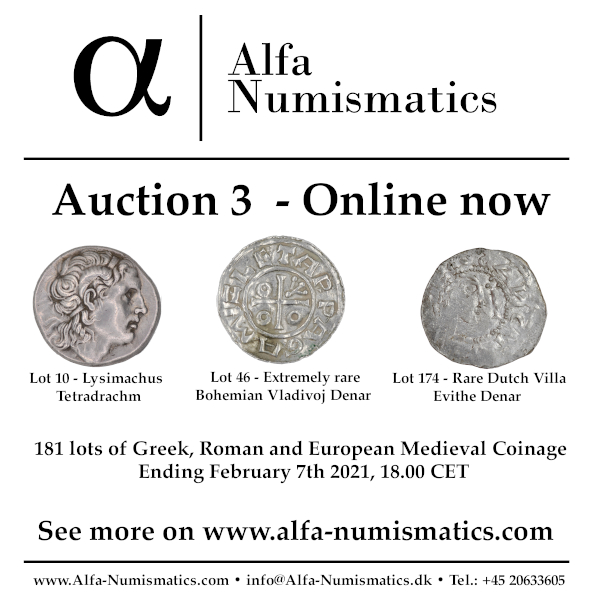
ART BERNSTEIN APPOINTED TO THE CCAC
In a press release published January 29, 2021, the U.S. Mint announced the appointment of Art Bernstein to the CCAC. Welcome! -Editor
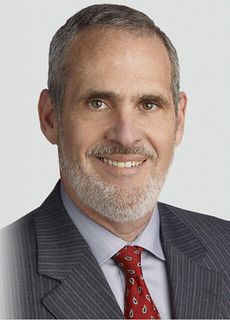 The United States Mint today announced the appointment of Arthur (Art) Bernstein to the Citizens Coinage Advisory Committee (CCAC) as one of three members appointed to represent the interests of the general public. Mr. Bernstein fills the vacancy created by the term expiration of Jeanne Stevens-Sollman who served two terms on the CCAC from 2012 to 2021. Mr. Bernstein's term is four years.
The United States Mint today announced the appointment of Arthur (Art) Bernstein to the Citizens Coinage Advisory Committee (CCAC) as one of three members appointed to represent the interests of the general public. Mr. Bernstein fills the vacancy created by the term expiration of Jeanne Stevens-Sollman who served two terms on the CCAC from 2012 to 2021. Mr. Bernstein's term is four years.
A passionate numismatist who enjoys sharing stories of his coin and banknote collections, Bernstein currently serves as the Chief Operating Officer at the law firm of Tucker Ellis LLP, based in Cleveland, Ohio.
Before joining Tucker Ellis, he spent 17 years as Executive Director at Hopkins & Carley in San Jose, California. Art is also a former Director of the Office of Financial Planning & Analysis at the State Bar of California in San Francisco, and previously worked for the County of San Mateo and the California State Legislature.
Art graduated from San Diego State University with a B.A. in Public Administration, from the University of Virginia with a M.A. in Public Administration, and from the University of Southampton (England) with a M.Sc. in International Politics. He remains active in the alumni associations of all three schools and is an avid fan of their sports teams.
Outside his role in law firm management, Art is an active Boy Scout Leader, serving as a local Scoutmaster and leading troops to International and National Jamborees. As a coin collecting merit badge counselor, he has counseled hundreds of Scouts in both California and Ohio, helping them to earn the Coin Collecting Merit Badge and further their advancement in Scouting. He is an Eagle Scout and a recipient of the Silver Beaver, and he currently serves on the Board of the Lake Erie Council, Boy Scouts of America.
Art also is a lifetime member of the American Numismatic Association, the American-Israel Numismatic Association, and the International Bank Note Society. Art and his wife Patricia McCall live in downtown Cleveland and Los Altos Hills, California.
The CCAC was established by an Act of Congress in 2003. It advises the Secretary of the Treasury on theme or design proposals relating to circulating coinage, bullion coinage, Congressional Gold Medals, and other medals produced by the United States Mint. The CCAC also makes commemorative coin recommendations to the Secretary and advises on the events, persons, or places to be commemorated, as well as on the mintage levels and proposed designs.
For more information, see:
Arthur P. Bernstein chief operating officer
(https://www.tuckerellis.com/people/arthur-bernstein)
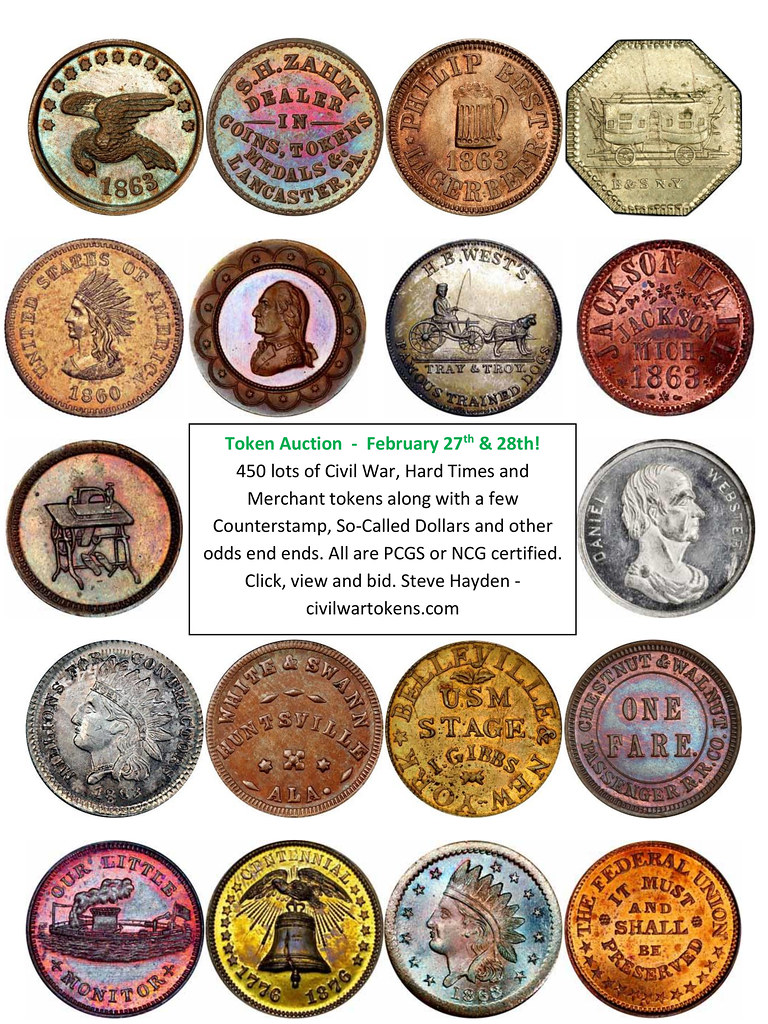
LOUIS GOLINO: 10 YEARS OF MODERN NUMISMATICS
Congratulations to Louis Golino on ten years writing columns on modern numismatics. His latest article summarizes that work. Here's an excerpt - see the complete article online. -Editor
 On January 7, 2011, I wrote an inaugural column for Coin Update about a new column that would cover developments in U.S. coins and in the American numismatic hobby and market.
On January 7, 2011, I wrote an inaugural column for Coin Update about a new column that would cover developments in U.S. coins and in the American numismatic hobby and market.
It has been an honor and a pleasure over the past decade to write on these topics and not just discuss developments in coins and why they were important but to learn a great deal from other collectors. Thanks to some interesting discussions with my readers here, especially when my pieces also appeared on Mint News Blog and World Mint News Blog, I now count some of those readers as valued friends.
About a year after starting this column, in early 2012 to early 2016. I took a hiatus while I increased the frequency of a column I have written for another publication also for the past decade. After Coin Update was acquired by Whitman Publishing, I returned and expanded my column to include coverage of world coins, especially the Mexican Libertad series — a personal favorite — and some economics-related topics like alternative currencies, the role of gold in the monetary system, and the Federal Reserve, which reflected my own interest in those areas and my belief that it is important for numismatists to understand them.
I have had the pleasure of interviewing officials from the U.S. Mint and other world mints, coin experts like Eric Jordan, dealers such as Ian Russell, hobby leaders like my friend Thomas J. Uram, who just completed a term as chairman of the Citizens Coinage Advisory Committee*, some amazingly talented coin designers and medallic sculptors such as Joel Iskowitz and Donald Everhart, and many others.
In some cases, such as my coverage of certain legislative coin measures like the various bills for an Apollo 11 50th anniversary coin program or the recently-enacted bill to create 2021 Morgan and Peace dollars, I have been able to have a small impact on helping to bring those efforts to fruition by trying to get more collectors interested in them, which led some to convey that interest to their congressional representatives.
The U.S. Mint and its major coin series — especially American Silver, Gold, Platinum, and Palladium Eagles, the America the Beautiful quarters, and commemorative coin programs — have, of course, loomed especially large in my columns and will continue to do so, except that the ATB series ends soon. As we all learned very recently, 2022 to 2030 will see the issuance of a large number of new quarters on prominent American women, then on youth sports, the semi-quincentennial of the nation, and paralympic sports, including some new half dollars as well as medals.
To read the complete article, see:
My column: 10 years covering modern numismatics
(https://mintnewsblog.com/my-column-10-years-covering-modern-numismatics/)
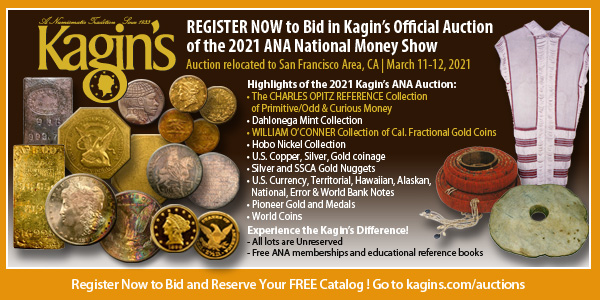
DAVISSONS ANNOUNCES E-AUCTION 40
In a January 29, 2021 email, Allan Davisson announced the 40th auction of Davissons Ltd. Great coins and medals! -Editor
 Our personal introduction to our catalogs usually launches right into talk about what you can find in these pages. I want to start somewhere else this time—discussing a few of the past owners of these pieces who deserve our thanks for the care they gave them and the fact that their collections are now available to others.
Our personal introduction to our catalogs usually launches right into talk about what you can find in these pages. I want to start somewhere else this time—discussing a few of the past owners of these pieces who deserve our thanks for the care they gave them and the fact that their collections are now available to others.
The Greek section of this sale has many superb pieces from two collections. One was a collector who left behind a file of his letters and invoices, dated around 1950, from still-remembered people and firms, an earlier era of numismatics—Spink & Son signed by L. Forrer, Glendining and Co. signed by Wm. French, and Numismatic Fine Arts on West 55th Street in New York signed by Edward Gans. Imagine a letter offering "Type of Alexander the Great with the name of Seleucos $25.00." He had a fine eye and, in that era, obviously had the pick of many choice pieces. Other choice Greek pieces in this section came from a collection formed by a scholarly collector who searched out the finest examples of the types that interested him. And thinking of earlier collections, the Roman section includes some "uncommon common" types from a collection formed in the 1920's—stylistic gems that bear a close look.
Frank Robinson—we go way back with Frank. I don't know when we first met but it must have been very early in our numismatic career. We were delighted when he offered his English collection, and we are still working through what began as several double-row boxes of carefully collected coins covering the three-and-a-half centuries of English milled coinage, mostly in good Extremely Fine to Uncirculated condition. He was careful in his selection and careful in his storage—everything was kept in acid-free envelopes with extensive notations on each. In addition to the obvious rarities this comprehensive collection has made many unexpectedly elusive pieces with modest catalog values available.
Michael Sussman's collection is another outstanding group—a comprehensive collection of high quality formed over a couple of decades. Every one of his tokens has been stored in a cloth insert inside an acid free envelope. He sought quality and comprehensiveness. In this sale we are offering the Spence tokens, a fascinating group with intriguing designs from a fascinating character trying to make a living with coins and tokens while fighting for free speech in Georgian London.
The collection of coins formed around the inventory of the collection of the US Mint published by James Snowden in 1860 forms the last major section of this auction. This large collection will be featured in all our 2021 sales. It represents a major effort by this thoughtful collector who used a variety of sources in Europe and America. We will offer it all—including inexpensive (and often seldom seen) pieces in upcoming sales. For this sale we concentrated on a broad sampling of silver with an emphasis on crowns. The history behind these pieces and the appeal of the designs has made the cataloging work particularly fascinating. (A Napoleonic kingdom that lasted six months, a short-lived 1790 insurrection inspired by what was going on in America, a monument to a king leaving his mother—these are a few of the quirkier reminders of the world from the mid-17th to the mid-19th century).
Finally, a few individual pieces have compelling stories:

Lot 10: Edward III Gold Leopard
• Two of the hammered gold pieces have been prized possessions for some time, the angel and the leopard. I remember when I bought each and was fond enough that I held them until a time when I wanted to be sure our gold section offered something special. (I still remember attending the remarkable sale of the Strauss collection in London in 1994—the extensively annotated catalog still sits on my shelf as a reference to consult.)
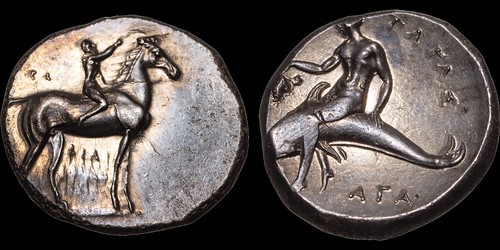
Lot 15: CALABRIA Tarentum Didrachm
• Before Lief came into our business I wrote the ancient section with help from Marnie. He and Marnie now handle it. When I looked at what they had assembled for this sale I was amazed. Our Greek section is more substantial than we often achieve, and we have been able to select many pieces of exceptional style and condition. Though last year's was no slouch, this is one of the more extensive representations of Greek silver we have had.
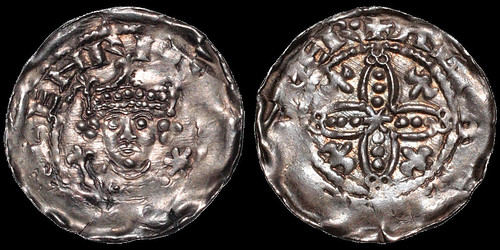
Lot 140: Henry I Quatrefoil Penny
• Our hammered English section is smaller than usual. Three pieces stand out because of the unusually choice condition of pieces struck under the most demanding circumstances—a Henry I quatrefoil penny on an even round flan, a deep strike on fresh metal and choice toning, a Stephen Watford penny with an impeccable pedigree that goes back to Rashleigh in 1909, and a Tealby penny that shares with the other two the same expertise exercised at the hands of a shearer who produced a round flan and a hammerman who got an exceptional amount of detail onto the piece.

Lot 185: Henry-the-Pretender Mary Stuart Ryal
• Why would I be the only person to handle two of the extremely rare Henry-the-Pretender irregular strikings of a Mary Stuart ryal where his name appears first as if he were actually declared king? I think the piece we sold for $7500 in 2015 drew this one. Outside of the Lockett example in the Edinburgh Museum, these are the only examples I have been able to trace. The life of Mary Stuart was an ongoing drama that has been preserved in coins and medals from the infant-head copper penny to the magnificent gold and silver that marked marriages and widowhoods. This fascinating piece is a footnote for one of the unfortunate chapters in her tragic life.
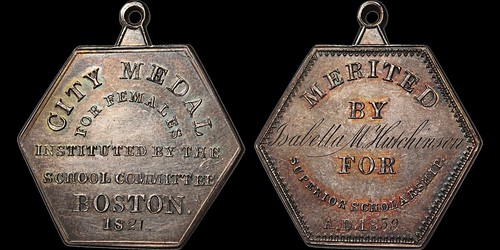
Lot 346: Boston School Medal
• We always seek "interesting and unusual" material to offer. This category has its expression on the last page of this sale—the Wells Fargo semicentennial, western silver mining, the British anti-slavery movement, a German Fire Brigade medal (very collectible), and a Boston School Medal (a series begun by Benjamin Franklin and also very collectible).
For more information, see:
https://davcoin.com/
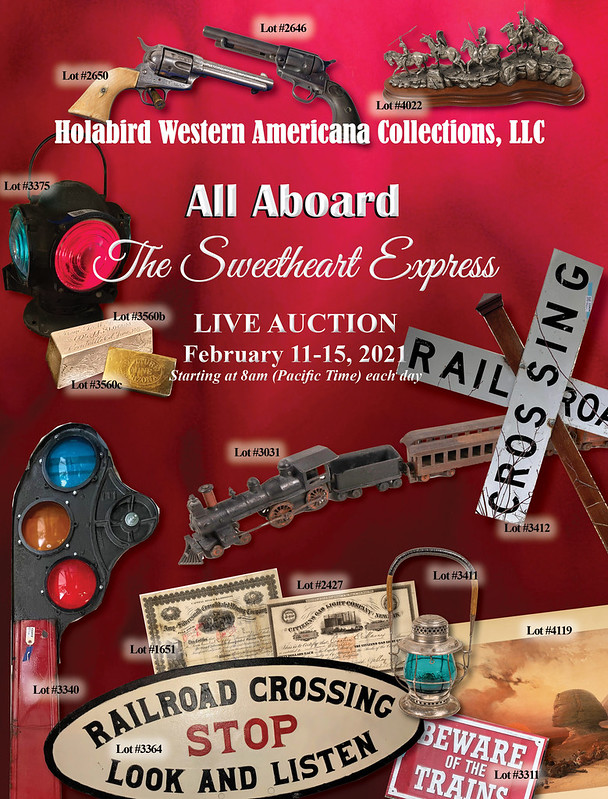
MORE HUNTER COLLECTION COLONIAL NOTES
Heritage cataloger Bruce Hagen submitted this additional selection of highlights from the Hunter collection of U.S. colonial notes. Thanks! -Editor
Revolutionary War Emblems and Mottoes
The Hunter Collection, containing notes from all thirteen colonies plus Continental Currency types, displays a wide variety of emblems and mottoes relating to the Revolutionary War: Continental Currency, with Latin text accompanying circular emblems originating in centuries-old reference books; Georgia color seal notes with a variety of imagery including Hope and Justice; the Maryland Allegorical series, featuring the graphic narrative of King George III stomping on the Magna Carta; Revere "Sword in Hand" issues, with the iconic Patriot backs; and the North Carolina 1776 $20 type featuring the rattlesnake image and anti- British "Don't Tread on Me" motto. All will be offered unreserved at auction on Thursday, February 11, 2021.
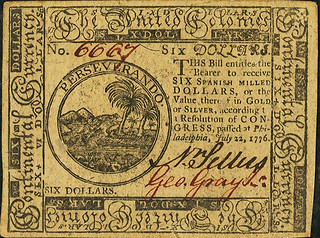
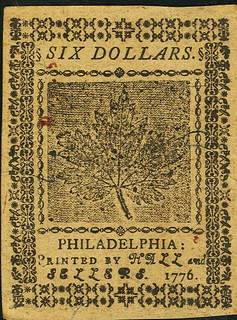
Continental Currency July 22, 1776 $6 Fr. CC-43 PCGS Choice New 63PPQ.
A scarcer type and quite difficult to encounter in this grade. This example is beautifully
balanced and sharply printed on both sides. The PERSEVERANDO (By perseverance)
motto accompanies the vignette of the beaver chewing on a tree. Framed precisely with
ample margins creating near-perfect face-to-back registration. The assigned grade may be
conservative, and this will fit ideally into a higher grade complete set or represent the
resolution as a perfect type note. Lot 94017 .
To read the complete lot description, see:
Continental Currency July 22, 1776 $6 Fr. CC-43 PCGS Choice New 63PPQ.. ...
(https://currency.ha.com/itm/colonial-notes/continental-currency-july-22-1776-6-fr-cc-43-pcgs-choice-new-63ppq/a/62160-94017.s)
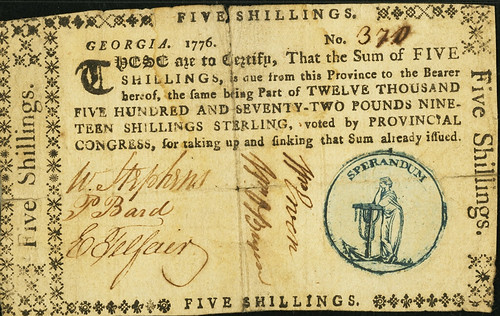
Georgia 1776 Sterling Denominations 5 Shillings Blue Seal Hope with
SPERANDUM Fr. GA-66a PMG Very Fine 20 Net.
The 1776 Blue Seal Hope with the SPERANDUM motto is a foundational type from the
Georgia Colonial currency series. The type is a great rarity, seldom encountered in any
condition, and very underrated. We believe there are less than a dozen examples known.
Its design is a reflection of the Revolutionary War spirit at the onset of hostilities. Most
issued Georgia 1776 Sterling five shilling notes featured the black printed Crown motif.
Those were deemed unpatriotic and evolved into this very limited blue color-seal type.
Following the Sterling issue, there were several issues of color-seal notes; however, this
is significant as the first. It is also the only use of this Hope motif and motto on Georgia
Colonial currency. In all grades it is a rare note, and the few encountered are usually very
low grade or damaged in some manner. The perfectly defined vignette shows a pensive
standing Hope leaning on her anchor with the motto SPERANDUM (One must hope)
arcing above. The paper has a clean, natural appearance from the face. However, there
are some faults noted by PMG as "Split, Tape Repairs." Old fashioned glassine was used
from the blank back to reinforce the splits. We have cataloged few of this rarity and the
type is essential for a definitive collection of Georgia seal notes. Lot 94097.
To read the complete lot description, see:
Georgia 1776 Sterling Denominations 5 Shillings Blue Seal Hope with SPERANDUM Fr. GA-66a PMG Very Fine 20 Net.. ...
(https://currency.ha.com/itm/colonial-notes/georgia-1776-sterling-denominations-5-shillings-blue-seal-hope-with-sperandum-fr-ga-66a-pmg-very-fine-20-net/a/62160-94097.s)
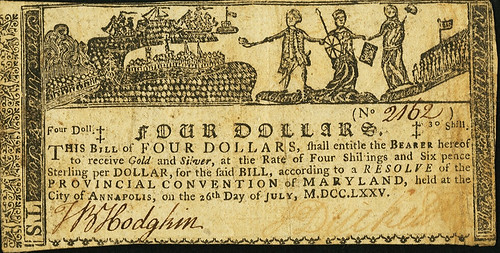
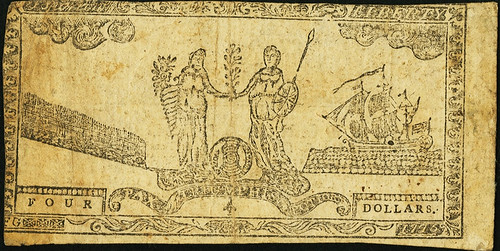
Maryland July 26, 1775 $4 Allegorical Series Fr. MD-76 PMG Very Fine 30.
A rare Allegorical Series note in impressive grade and among the finest known from the
issue. This beautiful example was formerly in the F.C.C. Boyd Collection and was the
original plate note featured in the first to fourth editions of Newman's reference, The
Early Paper Money of America, (EPMOA). A striking example that is nearly as sharp as
the prior $2 2/3 note.
The face design for the issue, adapted from a woodcut by Thomas Sparrow, shows standing Britannia receiving the petition (Cong / Peti) of the Continental Congress from America, who tramples the named scroll of Slavery. George III is shown stomping on the M[agna]Charta as he holds the torch to burn an American port being attacked by the British fleet. At each end (in the border cuts) are mottoes: at left, An appeal to HEAVEN and at right, Pro Aris et Focis (For altars and the hearth). The back allegory represents a future peace between America and Britannia; the motto on the scroll below is PAX TRIUMPHIS POTIOR (Peace is preferable to victory). In the corners, deftly placed in the borders, are clockwise from the upper left, signature of T.Sparrow, LIBERTY, 1775 and F.G. (for printer Frederick Green). The face is very boldly printed, the back somewhat lighter. However, all details are sharp on both sides. The margins are excellent, though the lower left is bowed in slightly into the border elements. The left end is very wide and complete. The back is centered a little to the left, leaving a wider margin at the right end. Ex: Stack's Ford Part III Sale, lot 744 (realized $10,350). An intriguing and fortuitous opportunity to bid upon one of the most outstanding notes from the issue within one auction. This is museum-caliber note boasts rarity, condition, and pedigree. Lot 94173.
To read the complete lot description, see:
Maryland July 26, 1775 $4 Allegorical Series Fr. MD-76 PMG Very Fine 30.. ...
(https://currency.ha.com/itm/colonial-notes/maryland-july-26-1775-4-allegorical-series-fr-md-76-pmg-very-fine-30/a/62160-94173.s)
One of the Finest Known from this Iconic Design Type
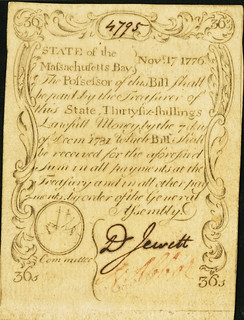
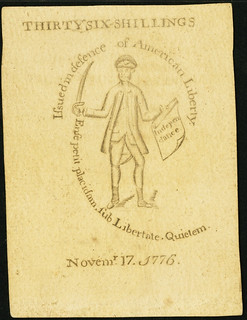
Massachusetts November 17, 1776 36 Shillings Fr. MA-251 PMG Choice About Uncirculated 58 EPQ.
An epic example from this series and one of the finest known "Swords" from any of the
four issues. This Minot Collection-pedigreed note is ten points higher on Track & Price
than the former Boyd Collection example, which was plated in Another "Independance"
example. There is a faint partial bend across the center; otherwise this note is immaculate.
The margins and centering are excellent on the broad paper. Ex: Stack's Keusch, Snow,
Del Zorro Collections Sale, November 18-19, 2008, lot 5655 (realized $27,600); Minot
Collection. An amazing note that has been cataloged for auction only twice. This
important highlight from the Hunter Collection is destined to be the center of an elite
cabinet of American Colonial currency rarities. Lot 94023 .
To read the complete lot description, see:
Massachusetts November 17, 1776 36 Shillings Fr. MA-251 PMG Choice About Uncirculated 58 EPQ.. ...
(https://currency.ha.com/itm/colonial-notes/massachusetts-november-17-1776-36-shillings-fr-ma-251-pmg-choice-about-uncirculated-58-epq/a/62160-94203.s)
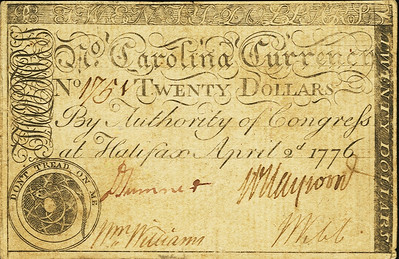
North Carolina April 2, 1776 $20 Rattlesnake Fr. NC-169 PMG Choice Very Fine
35.
The highest denomination on the series. It is an iconic type with the emblem composed of
the coiled Rattlesnake and DON'T TREAD ON ME motto representing the rejection of
British rule during the American Revolution. There are 13 rattles on the snake, symbolic
of the unity of the colonies. The "GL" script monogram, for engraver Gabriel Lewyn, is
at the upper left corner. Only 5,000 were printed, and high-grade notes are very scarce to
rare. Printed on thick laid paper (like the Newman and Coltrane examples) Cited only
with a "Tear" by PMG. It has full margins and sharp signatures. A justifiably popular
type. Lot 94296.
To read the complete lot description, see:
North Carolina April 2, 1776 $20 Rattlesnake Fr. NC-169 PMG Choice Very Fine 35.. ...
(https://currency.ha.com/itm/colonial-notes/north-carolina-april-2-1776-20-rattlesnake-fr-nc-169-pmg-choice-very-fine-35/a/62160-94296.s)
This important collection, featuring over 400 different Colonial note types, will be auctioned online on February 11, 2021, commencing at 6:00 PM Central Time (7:00 P.M. Eastern). Lot viewing is available by appointment only at Heritage's Office in Dallas; contact Jose Berumen at JBerumen@ha.com or 214-409-1299.
To read the earlier E-Sylum article, see:
HUNTER COLLECTION OF COLONIAL TYPE NOTES
(https://www.coinbooks.org/v24/esylum_v24n04a31.html)
THE BOOK BAZARRE
HERITAGE OFFERS NEW YORK NATIONAL BANKNOTES
This Heritage press release features rare notes from a collection of New York National Bank Notes. -Editor
Rare Currency Note From Beleaguered Bank Highlights New York State Paper Money Collection
Heritage Auctions will be holding a special Monthly Auction in February featuring a single-owner collection of New York State National Banknotes. Hotly contested by those who collect each of the state-authorized banknotes, national currency is a competitive area of collecting. Also, with more than 12,000 different banks across the US that issued notes, there are tons of ways to collect!
Between the 1860s and 1929, all 50 states and even Puerto Rico issued national bank notes. Banks that were nationally chartered had the ability to deposit bonds with the federal government that would act as collateral for issuing paper money with the bank's name and other locally-identifying features. Because the town and state that the bank was located in is featured prominently on these notes, the concept of collecting them regionally (ie all New Jersey or a certain town in Illinois where you grew up) is hugely popular. While national currency featured each local bank's details, the notes were printed at the Bureau of Engraving and Printing in DC. It was then legal not just in that state or town, but anywhere in the country.
The consignor of the Collar City Collection offers an array of notes to collectors, but one that caught my eye is a $1 National note from Troy, New York. Not only are there only 2 of these known in any condition, but the bank itself has an infamous backstory. Our catalogers explain the details:
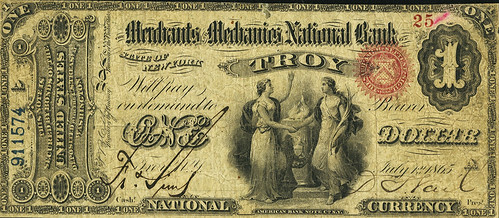
"Certainly one of the highlights of this great sale of upstate New York Nationals, this is an excessively rare note from the city of Troy's most short-lived issuer. The bank, originally established as a state-chartered institution in 1829, was dominated by the Vail family, a prominent old Dutch family in the Troy area. Originally opened by the patriarch of the family, George Vail, his son, D. Thomas Vail, obtained National status for the bank in 1865. However, the Vails were known as risk takers and, after just three years of National Bank Examiner supervision, the family gave up its federal charter and returned to the more relaxed auspices of a state-chartered institution. However, investing in over-valued assets finally caused even the then-complacent New York State Banking Department to close the doors in 1878 whereupon the Vail family was subjected to a series of lawsuits that lasted well into the 1880s.
For many years, the note we are offering was the sole example known from this briefly tenured bank. It has a provenance that traces back to Lot 2543 in Barney Bluestone's sale of the fabled Albert Grinnell collection in 1945. The note was acquired at the sale by pioneer paper money collector/dealer Bill Donlon who, years later, sold this Original Series ace to another old-time paper money collector, Forrest Daniel of North Dakota. Ironically, Mr. Daniel did not care about the bank's rarity - he just wanted an Original Series ace for a type set and liked the bank's title! Then, at the 1996 Memphis show, with your cataloger acting as broker, Mr. Daniel sold the note to an upstate New York collector who needed it in order to achieve a complete set of examples from all twelve of Troy's note-issuing National Banks. The collector passed away in 2009 and his collection was then dispersed in a 2010 Stacks sale. It was at that sale that our consignor acquired this extremely rare note.
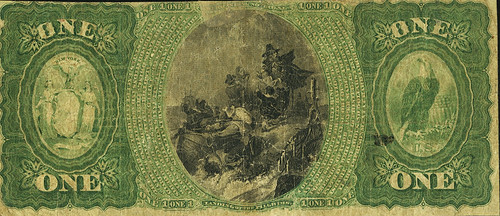
It is a moderately circulated note that was obviously rescued after spending some time in the channels of commerce. However, aside from a small tape repair, it is very attractive for the grade with pleasing color and bold pen signatures, including that of the infamous D. T(homas) Vail as President. At the time of its last auction appearance, it was still unique for the bank. Since then, another note has finally turned up but that piece is now ensconced in a long-term holding and will not be available until its owner leaves this mortal realm. Therefore, any collector seeking to obtain as many charters as possible from the "Collar City" needs this Original Series ace and should be prepared to pay whatever is necessary to bring it home."
Estimated at $6,000 to $8,000, this note will be a prize for anyone from Troy or who collects Large Size New York Nationals.
Check it out, then view the whole collection, here:
Troy, NY - $1 Original Fr. 380 The Merchants & Mechanics National Bank Ch. # 904 PMG Fine 12.
(https://currency.ha.com/itm/national-bank-notes/new-york/troy-ny-1-original-fr-380-the-merchants-and-mechanics-national-bank-ch-904-pmg-fine-12/a/62169-96097.s)

AIZANOI TURKEY COIN HOARD FOUND
Here's a story from Turkey about a nice ancient coin find. -Editor
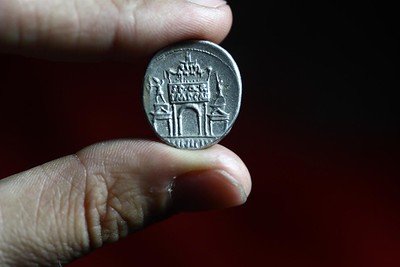
A rare collection of 651 silver coins belonging to the Roman period has been found in a jug during the ongoing excavations in the ancient city of Aizanoi, also known as the "Second Ephesus," in the western province of Kütahya's Çavdarhisar district.
Speaking to the state-run Anadolu Agency, the head of the excavations, Professor Eliz Özer, said that earlier German archaeologists were carrying out the excavation work in the ancient city, which is 48 kilometers away from the city center, but since 2011, Turkish experts have been continuing the work.
Noting that the rare silver coins were found in a jug in a stream passing through the ancient city, Özer said: "The jug was aimed to be kept by three terracotta plates covering it. The jug was carefully removed by the excavation team and there were 651 silver coins in it. It was determined that all of these coins belonged to the period of Augustus, one of the emperors of the Roman Republic period."

Noting that 439 of the silver coins were "denarius" and 212 of them were "cistophor," which were the monetary units of the time, Özer said that they believe that the coins might have been kept by a high-ranking soldier who came to Aizanoi.
Robert Hoppensteadt writes:
"Really interesting, and also cool that they were found by someone who didn't smuggle them out and sell them at auction. Probably a valuable hoard. These coins look all minted during the Imperatorial period and very early Imperial. I see a lot of Octavian and Mark Antony issues, many in high grade and some scarce to rare."
To read the complete article, see:
Roman silver coin collection found at Aizanoi
(https://www.hurriyetdailynews.com/roman-silver-coin-collection-found-at-aizanoi-161969)
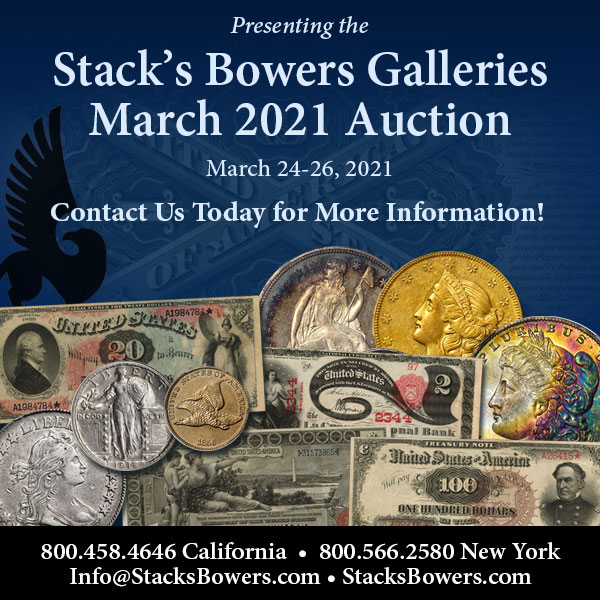
THE DIG - UNEARTHING THE SUTTON HOO TREASURE
Dick Hanscom forwarded this BBC article about the new film on the excavation of the Sutton Hoo, the magnificent buried Viking ship uncovered in England in 1939. -Editor

Netflix's The Dig tells the story of the Anglo-Saxon longship that was unearthed at Sutton Hoo in 1939. It was an extraordinary find in more ways than one, writes Neil Armstrong.
When the craft had been manoeuvred into the trench prepared for it, mourners laid the grave goods in the burial chamber in its centre. Then a mound was raised over it. And there the ship lay, moored fast in the East Anglian earth but journeying through time until, 13 centuries later on the eve of World War Two, a man called Basil Brown discovered it.
The incredible find, dubbed "Britain's Tutankhamun", is the subject of The Dig, a new Netflix film adapted from John Preston's novel of the same name. It stars Ralph Fiennes as self-taught archaeologist Brown and Carey Mulligan as Edith Pretty, the landowner who employed him to excavate the mysterious barrows on her estate at Sutton Hoo overlooking the River Deben in Suffolk.
Other ship burials had been excavated but nothing of this size. Before this, a 78-ft (23.8m) Viking vessel in Norway, discovered in 1880, had been the biggest. Because of previous finds elsewhere, Brown knew there might be a cargo of grave goods and on 14 June, he found what he thought could be the burial chamber – a wooden hut-like structure, now disintegrated, which had been constructed in the centre of the ship. But by now the men from the British Museum and Cambridge University had got wind of his great find and, just days later, muscled in on it. Before he could explore further, he was sidelined and relegated to basic labouring. The professionals couldn't have a local man – a mere amateur – dabbling. Why, the fellow didn't even have a degree!
A team of archaeologists was brought in and it was one of them, Peggy Piggott, who, on 21 July, just two days after her arrival, found the first piece of gold. Then she found another. And before long they had uncovered a glittering haul of more than 250 items for which the expression "treasure trove" barely seems adequate. There were feasting vessels and drinking horns and elaborate jewellery, a lyre and a sceptre, a sword, stones from Asia and silverware from Byzantium and coins from France (which helped date the hoard).
Brown's find literally caused the history books to be rewritten. The ship and its contents were, it transpired, from the Dark Ages, and the discovery illuminated those four centuries between the departure of the Romans and the arrival of the Vikings, about which so little was known. The Anglo-Saxons who ruled over England's various kingdoms during this time had been thought a crude and backward people – primitive almost – but here were exquisitely made items of great beauty. This was a society that valued skill, craft and art, and that traded with Europe and beyond.
The film is understated but powerfully affecting, with tremendous performances from both Fiennes and Mulligan. During a recent Q&A event for the film, Fiennes explained how he first read the screenplay on a plane "and at the end of it I was just in tears. I can't quite tell you why, but it's something to do with the integrity of the people unearthing this thing which represents something to do with nationhood."
To read the complete article, see:
The buried ship found on an English estate
(https://www.bbc.com/culture/article/20210127-the-buried-ship-found-on-an-english-estate)
David Sundman writes:
"The Netflix production is excellent, and also a very entertaining account of the Sutton Hoo dig in 1939, and numismatics play a part (as you know) to boot. I really enjoyed the Netflix production, which should win many awards, in my opinion."
David passed along a Wall Street Journal article about the film. -Editor
Every now and then a film comes along—not a great one, necessarily—that makes you deeply glad. It's how I feel about "The Dig." This modest and quirky feature, set in rural England immediately before World War II, dramatizes one of the most important archaeological finds of the 20th century, a pair of medieval cemeteries, one of them containing an Anglo-Saxon ship filled with magnificent artifacts. I'm glad it got made—not a sure thing at all in a relentlessly commercial market—and made with such intelligence and respect for the factual details of the discovery by people who obviously loved what they were doing; glad it's available to a wide audience on Netflix; and glad to have gained from it a heightened, and lengthened, sense of human history that the filmmakers convey in a style that's the antithesis of grandiose.
To read the complete article (subscription required), see:
‘The Dig' Review: Unearthing a Glittering Tale
(https://www.wsj.com/articles/the-dig-review-unearthing-a-glittering-tale-11611869591)
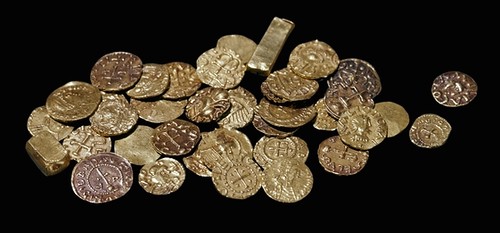
Sutton Hoo coins
For more information, see:
Anglo-Saxon Treasures from the Sutton Hoo Ship Burial
(https://brewminate.com/anglo-saxon-treasures-from-the-sutton-hoo-ship-burial/)
‘The Dig' Review: Carey Mulligan and Ralph Fiennes Crackle in Quiet Drama About the Stubbornness of History
(https://www.indiewire.com/2021/01/the-dig-review-netflix-carey-mulligan-ralph-fiennes-1234612538/)
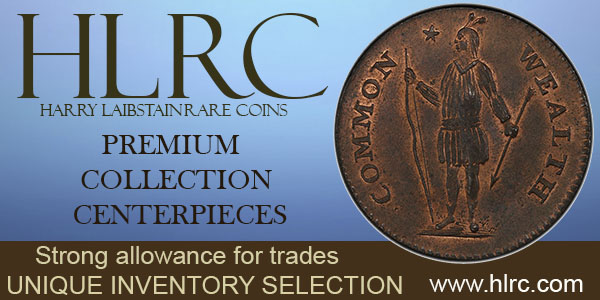
THE 2021 MORGAN DOLLAR
I didn't manage to get this one in last week's issue, but Dennis Tucker has written a nice article on the Mint News Blog about the new Morgan dollars coming out later this year. This is just an excerpt - see the complete article online for more, including a nice bibliography of books on the Morgan dollar. -Editor
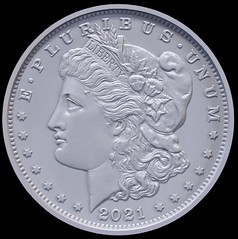
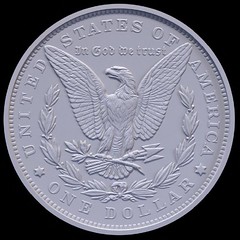
Mint rendition of the 2021 Morgan silver dollar.
For several generations, the Morgan silver dollar has ranked near the top of the list—if not sitting comfortably in the #1 spot—as the most popular classic American coin. Hobbyists collect them by date and mintmark, by die variety, and sometimes even by the roll or bag. There are folders, albums, display cases, and other ways to store and show off the hefty old coins. Entire books have been written about them. Even people who don't consider themselves coin collectors are familiar with, or at least vaguely aware of, the Morgan dollar. It's part of our national shared culture.
That awareness is about to take a sharp upward turn this year.
Morgan dollars started becoming popular with coin collectors in the 1950s. Then, something remarkable happened. In 1962, as the holiday season approached, bags of silver dollars that had been sealed in the Philadelphia Mint since 1929 were brought out of storage. They would meet the year-end demand from people who liked to give the fancy old-time coins as Christmas gifts. Soon it was discovered that the bags included Brilliant Uncirculated 1903-O dollars—at the time, considered to be the rarest of them all, worth $1,500 apiece! In the treasure hunt that followed, hundreds of thousands of coins of that particular date/mintmark were discovered in beautiful Mint State. Previously experts had estimated only a dozen or so had survived the Pittman Act melt of 1918.
Through 1963 and up to March of 1964, speculators and collectors lined up at banks and the Treasury Building to get their hands on the bagged-up riches. Some people even came with wheelbarrows, traded paper currency for cold hard cash, and left with 1,000-coin canvas sacks to search through. Hundreds of millions of Morgan dollars were brought back into the light of day (and into hobby collections). Then, when there were about three million coins remaining—many of them from the Carson City Mint—the Treasury put a stop to the payouts at face value. The last few million coins were auctioned off by the General Services Administration.
This flurry of activity, excitement, and competition cemented the popularity of the Morgan dollar. Instead of permanently oversaturating the market, the hundreds of millions of coins actually increased the number of active collectors, and values went up with the demand.
For 100 years, collectors have known those 1921 Morgan dollars as the last of their breed—but that's about to change. For 2021, Congress has authorized the minting of new centennial dollars to celebrate the famous coin series and mark the 100th year of its (previously) final issue.
The Citizens Coinage Advisory Committee convened by videoconference on January 19, 2021, to review designs for the new Morgan dollars. U.S. Mint Chief Engraver Joseph Menna and Ron Harrigal, the Mint's manager of design and engraving, discussed the process of creating the new coins. They will be an "homage" or "rendition" of the old silver dollars, crafted from a variety of Mint assets and records to "honor the original intent of the original artists as much as possible," as Menna said. Harrigal pointed out that the change from the historical .900 fineness to .999 fine silver would cause a minuscule reduction in planchet volume. Modern technology will bring improvements over what was available a century ago. CCAC members reviewed computer-generated illustrations of the new designs and were pleased with the outcome.
The coins are being minted under the 1921 Silver Dollar Coin Anniversary Act, signed into law by President Donald Trump on January 5, 2021. It "requires the Department of the Treasury to mint and issue coins in honor of the 100th anniversary of the completion of coinage of the Morgan dollar and the 100th anniversary of the commencement of coinage of the Peace dollar." The legislation was the brainchild of two members of the CCAC, chairman Thomas Uram and Michael Moran. Both are longtime numismatists and published researchers active in the hobby community. Several committee members praised Uram and Moran during the January 19 meeting for their persistence and hard work in getting congressional support for the legislation. The two numismatists, in turn, thanked Kentucky congressman Andy Barr, whose faith in them and the project helped bring it from dream to reality.
To read the complete article, see:
The triumphant return of the Morgan silver dollar
(https://mintnewsblog.com/the-triumphant-return-of-the-morgan-silver-dollar/)

HARD TIMES TOKENS AND SCRIP
An article elsewhere in this issue discussed Alexandre Vattemare's 1864 article on Hard Times Tokens. Here's a recent article by Amelia Soth on the topic. Found via News & Notes from the Society of Paper Money Collectors (Volume VI, Number 32, January 26, 2021). It's a popular article and not particularly scholarly, but I was intrigued by the illustration of tokens from the Cornell University Collection of Political Americana. -Editor

If you were in Baltimore, circa 1837, you might have bought your bread with a tiny political cartoon. Small change was hard to come by. In its absence, penny-like coins known as "hard times tokens" circulated widely, a form of unofficial currency.
Hard times tokens seem like normal pennies—until you take a closer look. To avoid charges of counterfeiting, the text on the tokens frequently proclaimed that they were "Not One Cent/But Just As Good." In the place of the familiar Lincoln's head, you might notice a ship being wrecked against the rocks, a leaping jackass, or Andrew Jackson popping out of a treasure-chest like a Jack-in-the-Box, encircled by the phrase "I take the responsibility." These images are succinct expressions of the anger and disappointment felt in the wake of the Panic of 1837 and the economic depression that followed it.
Alongside the hard times tokens, a variety of unofficial paper money known as "shinplasters" circulated. The name came from the thin and weak material they were made of, which resembled bandages. Local stores issued their own cheaply-printed shinplasters, and they travelled swiftly through local economies, wherever people would accept them. One contemporary observer recalled seeing a man on the street who carried a whole roll of shinplaster bills tucked into his silk top hat. Whenever he needed to buy something, he would clip off a fresh bill with a pair of scissors.

These alternative currencies raised curious legal questions. In one court case, a man who had stolen a wallet was found not guilty, since the shinplaster notes inside were not technically money. Yet bills from authentic banks could be just as dubious. People were on high alert for money issued by "wild-cat banks"—so called because, supposedly, they were hidden away in remote forests and swamps where only wild cats lived.
To read the complete article, see:
"Hard Times Tokens" Were Not One Cent
(https://daily.jstor.org/hard-times-tokens-were-not-one-cent/)

NUMISMATIC COMMEMORATIONS OF VACCINATION
American Numismatic Society Collections Manager Dr. Elena Stolyarik published an ANS Pocket Change blog article December 29, 2020 on the timely topic of numismatic commemorations of vaccination. Here's an excerpt - be sure to read the complete article online. -Editor
The year 2020, which brought to the world a coronavirus pandemic, is coming to an end. Humanity looks forward with hope to successful innovations against the new deadly virus. This is an appropriate time to pay tribute to the achievements of scientists of previous generations.
For the topic of vaccination, the name of the English doctor Edward Jenner (1749–1823), outstanding physician and pioneer of smallpox vaccination, is foremost. For centuries, smallpox swept through communities, often killing nearly a quarter of its victims and leaving many of the survivors deeply scarred or blind. In 1796, Edward Jenner demonstrated that an infection with the relatively mild cowpox virus conferred immunity against the deadly smallpox virus. Jenner even created the word "vaccination", derived from the Latin word vacca, meaning "cow". Jenner's vaccine was one of the great triumphs of medicine, which first brought smallpox under medical control and opened the way for the eventual elimination of this disease. The results from Jenner's vaccination experiments were widely circulated after their publication in 1798, and vaccination was promoted as a public health tool throughout Europe.
A number of medals by the German medalist Friedrich Wilhelm Loos (1767—1816/19) are dedicated to Jenner's discovery of smallpox vaccination. They not only pay tribute to Jenner's workbut also served as rewards for parents who had their children vaccinated. They were intended to indicate the importance of the vaccination programs.

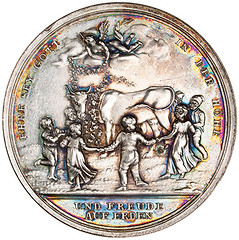
Prussia. Silver medal of Edward Jenner, by Friedrich Wilhelm Loos, Berlin mint
Some of the medals, like a silver medal from the time of Napoleon, depicting a cow and some medical instruments, were presented to doctors in recognition of the vaccinations they had given. This medal, designed by the French artist and engraver Alexis Joseph Depaulis (1790–1867) , reflected the importance of the doctors who were attached to vaccination programs.
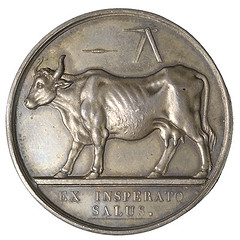
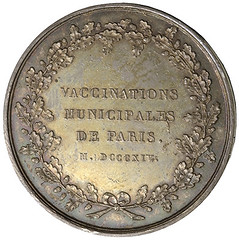
France. Award medal of the Parisian municipal vaccination program, by Alexis Joseph Depaulis, Paris, 1814
In the mid-nineteenth century, research brought many new insights about infectious diseases. The prominent French biologist, Louis Pasteur (1822–1895), introduced innovative experiments and techniques, which became fundamental to modern microbiology. He researched the microorganisms that cause dangerous diseases and discovered how to make vaccines from weakened microbes. Based on those studies, Pasteur developed the earliest vaccines against major veterinary diseases such as chicken cholera, anthrax, and rabies
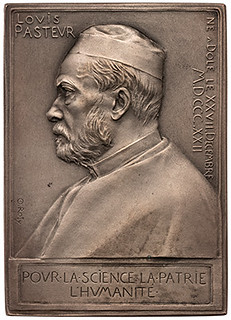
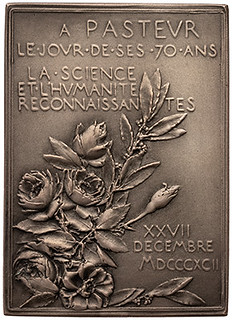
France. Silver plaque for the 70th birthday of Louis Pasteur, by Louis-Oscar Roty, 1892
Unfortunately, epidemics cannot be avoided and new diseases attack the world from time to time. However, the memory of the pioneers of science who have helped shape human lives for the better inspires our belief in the successful discovery of new treatments and vaccines.
To read the complete article, see:
NUMISMATIC COMMEMORATIONS OF VACCINATION RESEARCH
(http://numismatics.org/pocketchange/vaccination/)
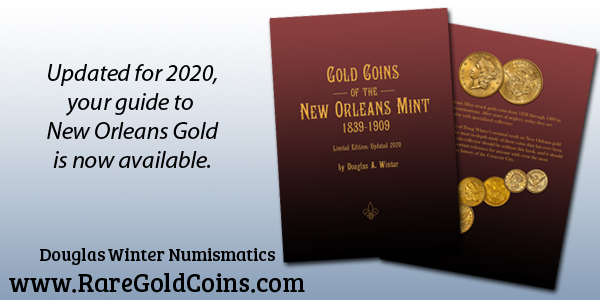
NEW MOMENTUM TO PUT HARRIET TUBMAN ON $20 BILL
Kellen Hoard forwarded this news item about the push to put Harriet Tubman on the $20 bill. Thanks also to Dick Hanscom and others who forwarded articles on the topic. -Editor
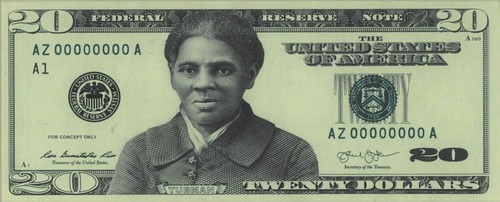
A BEP facsimile design sans security features
The Biden administration will revive the push to make Harriet Tubman the face of a new $20 bill, an effort that was shelved during former President Donald Trump's term.
"We're exploring ways to speed up that effort," White House press secretary Jen Psaki told reporters Monday after being asked if the new administration would pick up the Obama-era initiative.
An updated $20 note featuring Tubman, the former slave who became an icon of the abolitionist movement, was originally set to be unveiled around the 100th anniversary of the 19th Amendment, which granted women the right to vote.
But Trump's Treasury secretary, Steven Mnuchin, announced during a 2019 congressional hearing that the redesign would be delayed until 2028. Mnuchin said at the time that the primary reason for redesigning a currency is to combat counterfeiting efforts.
Psaki said Monday that the Treasury Department is "taking steps to resume efforts" to put Tubman's image on the front of the new $20 bills.
It's important for the bills to "reflect the history and diversity of our country," Psaki said, "and Harriet Tubman's image gracing the new $20 note would certainly reflect that."
Producing the new $20 notes with robust anti-counterfeiting technology and other security measures in place will require a new high-speed printing facility, which is currently scheduled for 2025.
Concepts for an updated $50 note are in development.
To read the complete article, see:
Biden's Treasury revives push to put Harriet Tubman on $20 bill after Trump shelved it
(https://www.cnbc.com/2021/01/25/harriet-tubman-20-bill-biden-revives-push-after-trump-shelved-it.html)
Here's an excerpt from the Wall Street Journal's coverage. -Editor
 The redesign of the bill would place a woman on the front of U.S. paper currency for the first time in more than a century and replace the nation's seventh president, Andrew Jackson, a slave owner who stared down an early threat of secession imperiling the union. In the new design, Jackson would move to the back of the note.
The redesign of the bill would place a woman on the front of U.S. paper currency for the first time in more than a century and replace the nation's seventh president, Andrew Jackson, a slave owner who stared down an early threat of secession imperiling the union. In the new design, Jackson would move to the back of the note.
The Treasury Department's watchdog agreed in 2019 to review the agency's plan after Democrats said the Trump Treasury Department had intentionally slow-walked the proposal.
As a candidate in 2016, Mr. Trump had rejected the idea of putting Tubman on the bill. During his term he expressed admiration for Jackson, kept a portrait of him in the Oval Office and visited Jackson's tomb at the Hermitage in Nashville early in his presidency.
Former Treasury Secretary Steven Mnuchin said in 2019 that plans to unveil the Tubman bill would be postponed until at least 2026.
Tubman was born a slave around 1822 on Maryland's Eastern Shore and became a leading abolitionist and suffragette. She escaped slavery in 1849 but spent the next decade repeatedly returning to Maryland to help free her friends and family through the Underground Railroad, a network of people and places that helped slaves safely escape to the north.
To read the complete article (subscription required), see:
Treasury Resuming Efforts to Put Harriet Tubman on $20 Bill
(https://www.wsj.com/articles/treasury-resuming-efforts-to-put-harriet-tubman-on-20-bill-11611602005)
Biden administration revives effort to put Harriet Tubman on $20 bill (https://www.msn.com/en-us/news/politics/biden-administration-revives-effort-to-put-harriet-tubman-on-20-bill/ar-BB1d5aQO?li=BBnbcA1)
Gary Beals passed along an alternate view of the optics of placing the image of an enslaved person on money. Published in Time magazine, the author is Brittney Cooper, a professor at Rutgers University and the author of Eloquent Rage: A Black Feminist Discovers Her Superpower. -Editor
Gary writes:
"This item stopped me in my numismatic tracks. I thought honoring a powerful historic figure on a banknote was a good idea. Turns out there is a dark side on this action."
Putting Tubman on legal tender, when slaves in the U.S. were treated as fungible commodities is a supreme form of disrespect. The imagery of her face changing hands as people exchange cash for goods and services evokes for me discomfiting scenes of enslaved persons being handed over as payment for white debt or for anything white slaveholders wanted. America certainly owes a debt to Black people, but this is not the way to repay it.
... we should note, that Black people's faces have, in fact, been on our national currency before. During the Confederacy, as each secessionist state printed its own money, images of enslaved people picking cotton and doing other forms of menial labor appeared on the currency in several states.
Harriet Tubman's life was about fighting against the system that treated Black lives and Black bodies as property, currency and capital. She was a great emancipator, freeing herself and hundreds of others and helping to bring the Union forces to victory working as spy in South Carolina during the Civil War. Would she consider it an honor to have her likeness plastered on American currency? And if she agreed to the honor, what would she ask for in return?
To read the complete article, see:
Putting Harriet Tubman on the $20 Bill Is Not a Sign of Progress. It's a Sign of Disrespect
(https://time.com/5933920/harriet-tubman-20-bill-joe-biden/)
To read earlier E-Sylum articles, see:
WHAT HAPPENED TO THE HARRIET TUBMAN PLAN?
(https://www.coinbooks.org/v21/esylum_v21n16a33.html)
BEP PREPARED HARRIET TUBMAN FACSIMILE DESIGNS
(https://www.coinbooks.org/v22/esylum_v22n24a32.html)

RAID NETS UK'S LARGEST COUNTERFEIT SEIZURE
A recent police raid in Beckenham, England disrupted a £12 million counterfeiting scheme. -Editor
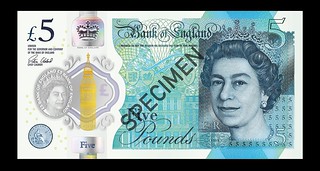 NEWS OF the UK's largest cash counterfeiting scam to date has, according to the International Hologram Manufacturers Association (IHMA), "focused fresh attention" on the vital importance of stepping up investment in effective security devices designed to protect the nation's banknotes.
NEWS OF the UK's largest cash counterfeiting scam to date has, according to the International Hologram Manufacturers Association (IHMA), "focused fresh attention" on the vital importance of stepping up investment in effective security devices designed to protect the nation's banknotes.
John Evans, Phillip Brown and Nick Winter have been jailed for their part in an organised crime group conspiracy to supply more than £12 million worth of counterfeit banknotes. The trio's imprisonment follows a lengthy and complex investigation conducted by specialist detectives from the Kent and Essex Serious Crime Directorate and which included what's believed to have been the single largest face-value seizure of fake currency in UK history in the wake of a police raid at an industrial unit located in Beckenham.
Support for the investigation was provided by the Bank of England and the Counterfeit Currency Unit at the National Crime Agency.
The police investigation into the criminal group's activities began in January 2019 after the Bank of England had identified a new counterfeit £20 note that appeared to have been produced using the type of specialist printing equipment that would normally be associated with a company that produces large volumes of magazines or leaflets.
Following several months of enquiries, including mobile phone analysis of those believed to have been involved in its production, a search warrant was carried out at a business premises owned by Winter in Kent House Lane, Beckenham on Saturday 4 May 2019. Once inside the premises, officers found Brown and another man surrounded by printing equipment and large piles of counterfeit £20 notes, which were later confirmed as having a total face value of £5.25 million – believed to be the single largest face-value seizure of counterfeit currency in history. Upon his arrest, Brown told the officers: "You have caught me red-handed."
A subsequent search of Brown's home address led to the discovery of a list of names with numbers next to them that added up to 5.25 million – the same value of the counterfeit notes. Winter had been on holiday in America at the time his business was raided, but was arrested upon his return to the UK on Sunday 26 May 2019.
On Wednesday 9 October 2019, a dog walker found around £5 million worth of fake banknotes dumped in Halt Robin Road in Belvedere. A further £200,940 was found scattered along the railway line between Farningham and Longfield on Wednesday 15 January last year, with the Bank of England having already identified and removed around £1.6 million worth from general circulation.
To read the complete article, see:
UK banknote protection thrown into sharp focus by large-scale counterfeiting scam
(https://www.fsmatters.com/UK-banknote-protection-methods-in-sharp-focus)

HONG KONG COUNTERFEIT BANKNOTES RISING
Bogus banknote seizures are up in Hong Kong, too. This article describes the raid of a low-quality counterfeiting operation. -Editor
 Police arrested a mother-daughter pair and seized 54 bogus HK$500 banknotes on Thursday.
Police arrested a mother-daughter pair and seized 54 bogus HK$500 banknotes on Thursday.
The number of bogus banknotes of various denominations seized in the first 11 months of 2020 rose by 68 per cent year on year to nearly 13,500, up from 8,009 in 2019, according to the latest figures.
Police seized 11,771 counterfeit HK$1,000 (US$129) banknotes between January and November, 2020, up 103 per cent from 5,785 in the whole of 2019.
Police warned Hongkongers to be aware of bogus banknotes ahead of Lunar New Year following the discovery of a makeshift counterfeit note workshop in a public housing flat in Fanling.
Officers arrested the flat's tenant and her daughter, seizing 54 bogus HK$500 banknotes along with unfinished notes and production equipment on Thursday evening.
The arrests were made after police found more than 50 counterfeit banknotes of different denominations had been circulating, mainly in the New Territories, since December.
After examining security camera footage, police identified a 43-year-old woman who was suspected of being linked to five cases of fake note circulation over the past three weeks.
"The seized fake bills were made with an inkjet printer. Glitter pens were used to make security features such as windowed metallic thread on the notes in an attempt to fool people," Senior Inspector Barry Tang Kwok-hin of the commercial crime bureau said.
He said the bogus notes were of poor quality and the fakes could be easily distinguished because the bills lacked security features and an embossed feel.
To read the complete article, see:
Bogus banknote seizures up 68 per cent last year, as Hong Kong police raid fake bill workshop, detain mother-daughter pair
(https://www.scmp.com/news/hong-kong/law-and-crime/article/3119821/bogus-banknote-seizures-68-cent-last-year-hong-kong)
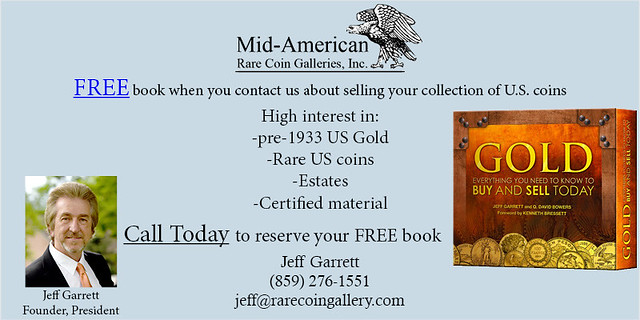
LOOSE CHANGE: JANUARY 31, 2021
Here are some additional items in the media this week that may be of interest. -Editor
New York Federal Gold Vault
Atlas Obscura has an article about the gold vault at the New York Fed. -Editor
 THE LARGEST ACCUMULATION OF GOLD in human history is located deep underneath the heart of Manhattan's financial district, at the New York Federal Reserve Bank. Some 80 feet beneath sidewalk level, the Fed's special vault is built into the bedrock and entrusted with deposits from central banks across the globe. Inside sits 7,000 tons of glittering gold bars—around 5 percent of all of the gold ever mined.
THE LARGEST ACCUMULATION OF GOLD in human history is located deep underneath the heart of Manhattan's financial district, at the New York Federal Reserve Bank. Some 80 feet beneath sidewalk level, the Fed's special vault is built into the bedrock and entrusted with deposits from central banks across the globe. Inside sits 7,000 tons of glittering gold bars—around 5 percent of all of the gold ever mined.
The only way into the vault is via a cylindrical entryway that rotates at the turn of a wheel. A sliver-shaped pie chunk of the cylinder has an opening, and when properly aligned with the entry hallway allows access to the treasure inside. Inside there are 122 separate mini-vaults (one for every country), plus a "library vault" for account holders with smaller deposits.
To read the complete article, see:
New York Federal Gold Vault
(https://www.atlasobscura.com/places/new-york-federal-gold-vault)
On Circulating Commemorative Programs
In his The Coin Analyst column on CoinWeek, Louis Golino asks, "Have Circulating Commemorative Programs Outlasted Their Welcome?" -Editor
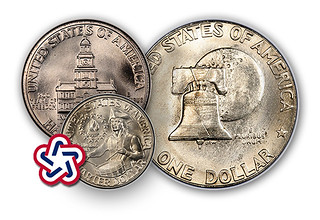 A major new bill that will create several new series of circulating commemorative quarters and other coins has just become law. Unfortunately, it risks repeating several of the mistakes of other recent coin programs of this type.
A major new bill that will create several new series of circulating commemorative quarters and other coins has just become law. Unfortunately, it risks repeating several of the mistakes of other recent coin programs of this type.
Ever since word of the new circulating coin programs received coverage in the numismatic press, reactions from collectors have been almost universally negative with the exception of the semi-quincentennial coins that are reminiscent of the 1975-1976 Bicentennial coins that were very popular.
Comments from collectors in the blogosphere and letters to editors of numismatic publications called the program "overboard and mostly covering unneeded themes"; noted that a "rest [in such programs] is long overdue" or said that state quarters were "fun, but the idea has been overplayed."
To read the complete article, see:
The Coin Analyst: Have Circulating Commemorative Programs Outlasted Their Welcome?
(https://coinweek.com/modern-coins/the-coin-analyst-have-circulating-commemorative-programs-outlasted-their-welcome/)



